Discover the world of modern and contemporary art from Africa and its diaspora with Pavillon 54's magazine. Engage in enlightening articles, captivating interviews, comprehensive editorial coverage, enriching videos, and stimulating experiences. Join our community to stay informed, learn, and actively participate in the dynamic landscape of African art.
-
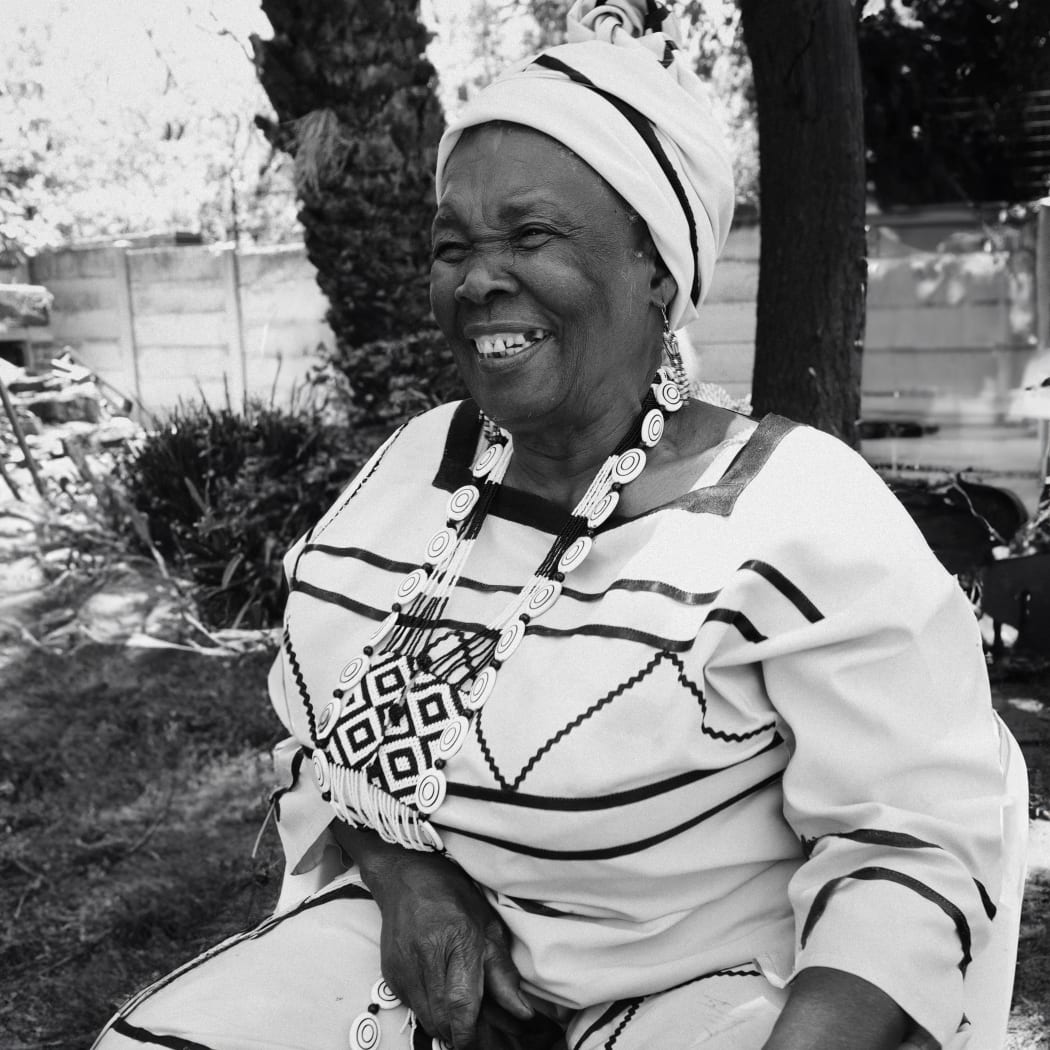 Pavillon54 team had the pleasure to meet and interview South African modern master Helen Sebidi. With a new show ahead, and retrospectives of her illustrious career, Helen Sebidi remains remarkable and worthy of admiration.
Pavillon54 team had the pleasure to meet and interview South African modern master Helen Sebidi. With a new show ahead, and retrospectives of her illustrious career, Helen Sebidi remains remarkable and worthy of admiration. -
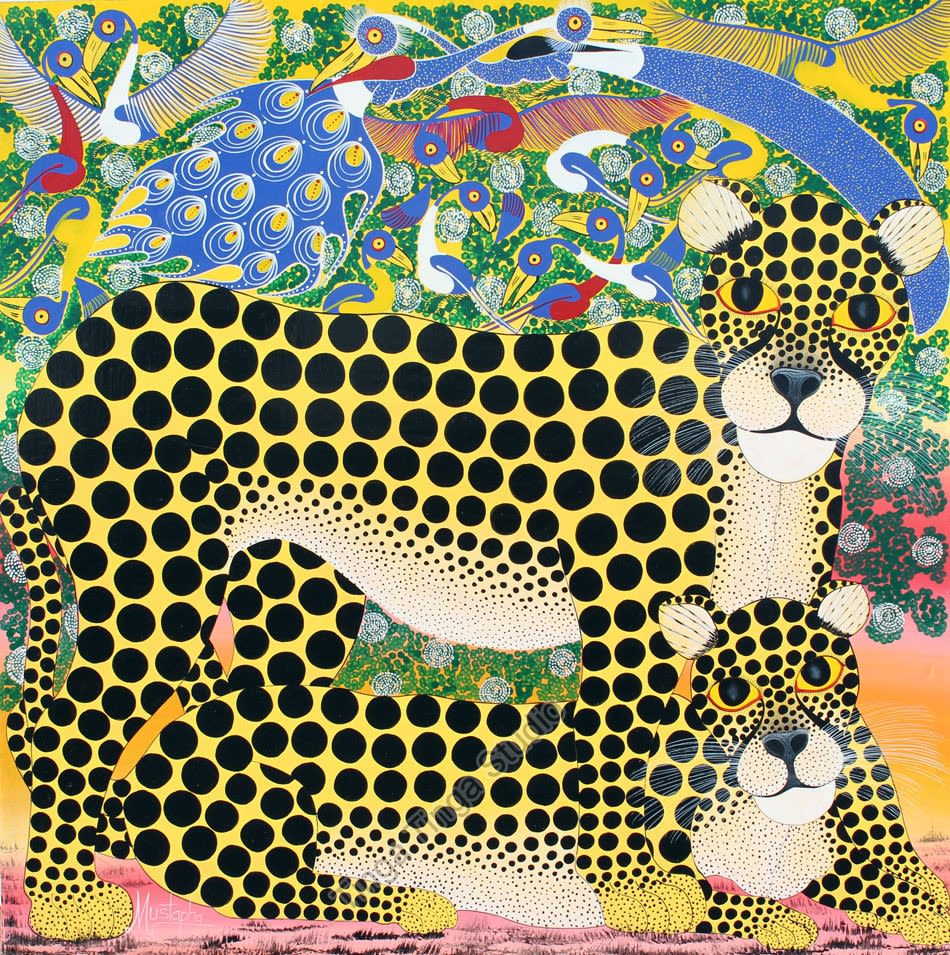
In this article, Pavillon54 explores the world of Tinga Tinga art, a distinct painting style that originated in East Africa, particularly in Tanzania.
-
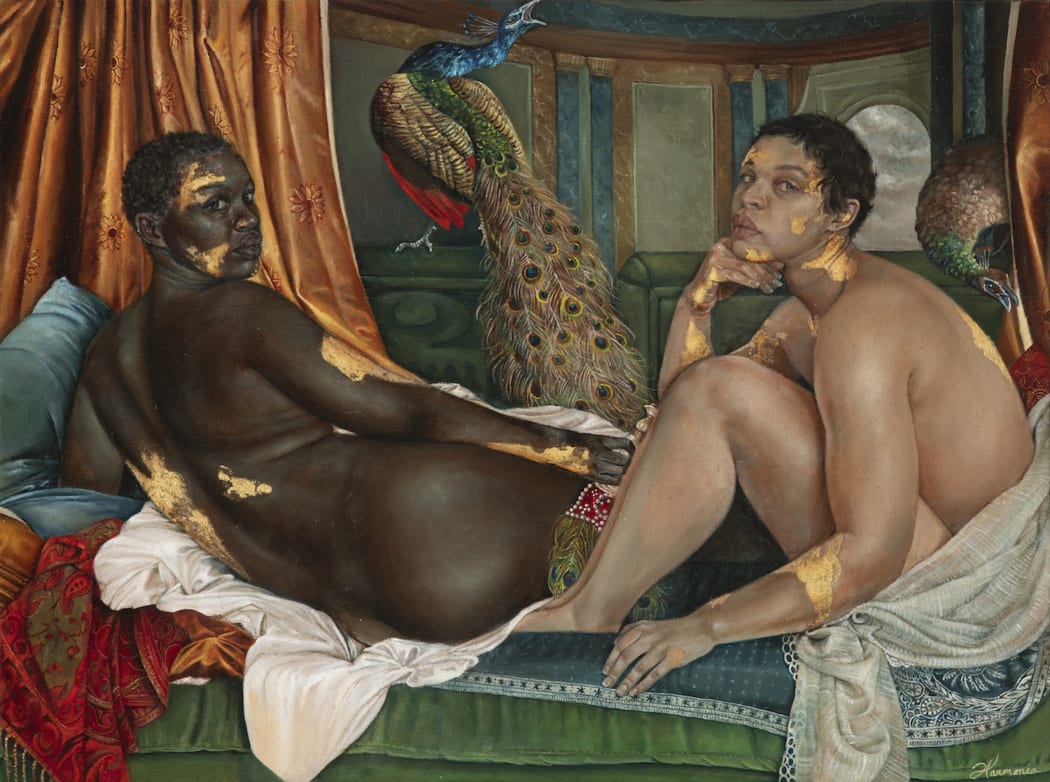
African artists are redefining the Renaissance period by infusing art historical references into contemporary works, recasting works like Pietà by Michelangelo, David by Donatello, and Mona Lisa by Leonardo da Vinci, amongst others, with africans subjects. There is a contemporary interpretation of classical and portraiture traditions in works of African artists like Harmonia Rosales, Victoria Makinde, Chidinma Nnoli, Arthur Timothy, Kehinde Wiley, Christopher Samuel Idowu, and Oliver Okolo. These artists are exploring pressing issues by placing their contemporary subjects in a reimagined classical context.
-
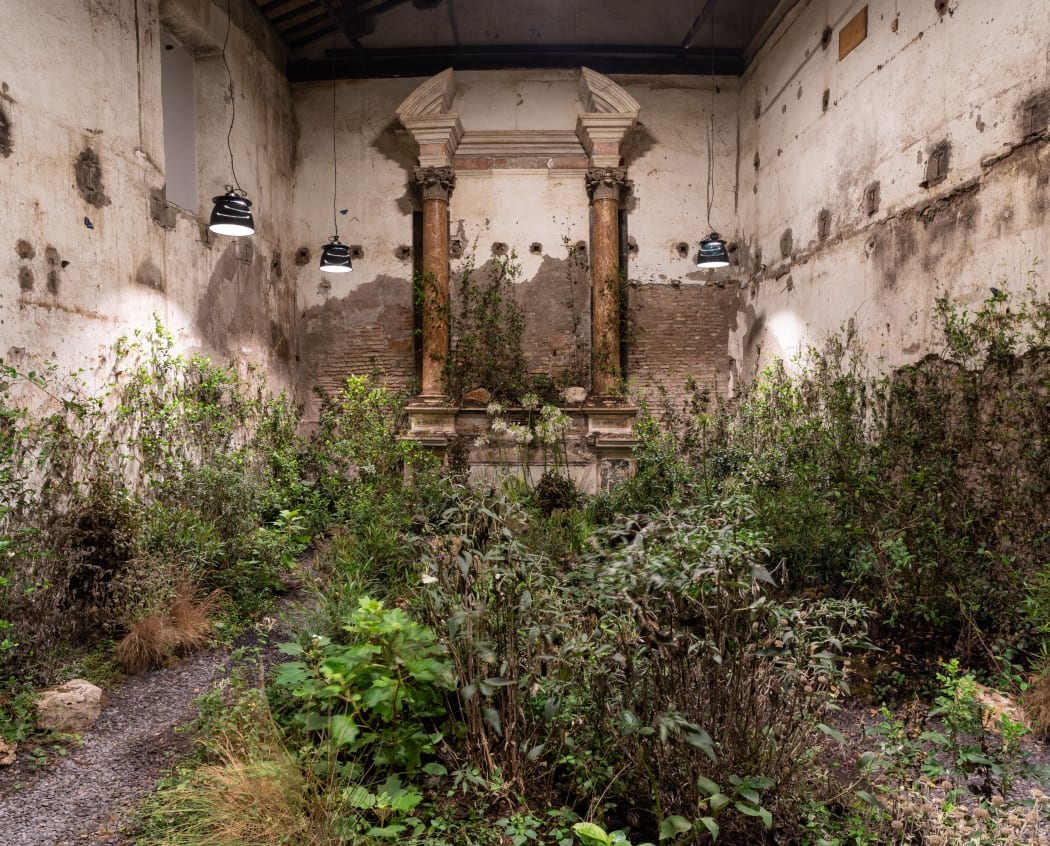
In the investigation of identity and reconciliation of forgotten histories to the present, the concept of a place is significant to the African art narrative. As an active observer of their immediate environment, an artist is in constant dialogue with a place, physical or non-physical.
There’s more emphasis on what the place means to an African artist in their practice, and this exploration could be political, social or metaphysical as they examine identity, culture, history and the complex relationships between people and their environment. From time to time, African artists have reimagined varied immersive spaces to interrogate diverse topics that affect society. In all, they are questioning and redefining the notion of place in the context of a rapidly changing world.
-
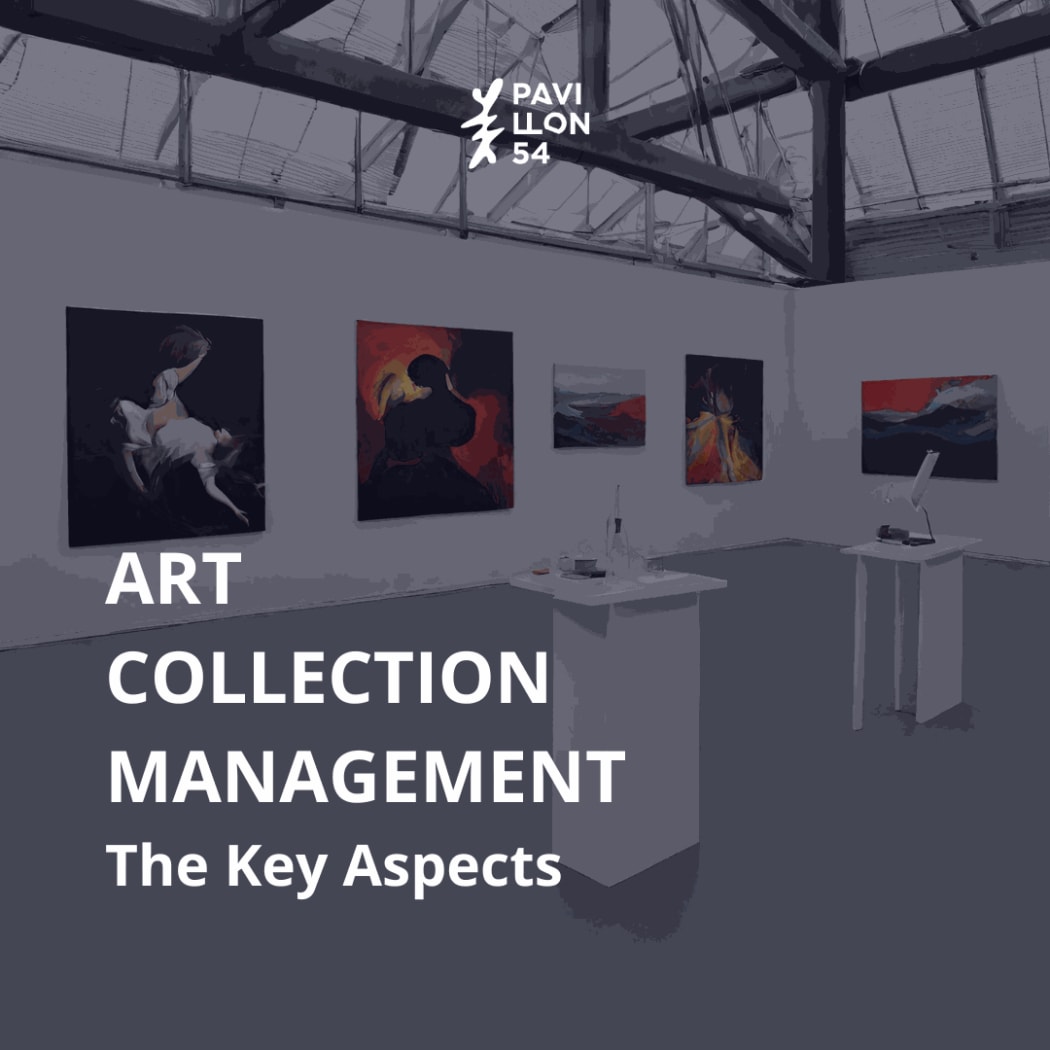 Art collection management is a multifaceted discipline that requires a combination of art expertise, organisational skills, and the use of specialised tools to ensure the longevity and cultural significance of the artworks within a collection. It is an important aspect of managing both private and public collections for a number of reasons. In this short article we explain the key aspects and reasons collection management is vital.
Art collection management is a multifaceted discipline that requires a combination of art expertise, organisational skills, and the use of specialised tools to ensure the longevity and cultural significance of the artworks within a collection. It is an important aspect of managing both private and public collections for a number of reasons. In this short article we explain the key aspects and reasons collection management is vital. -
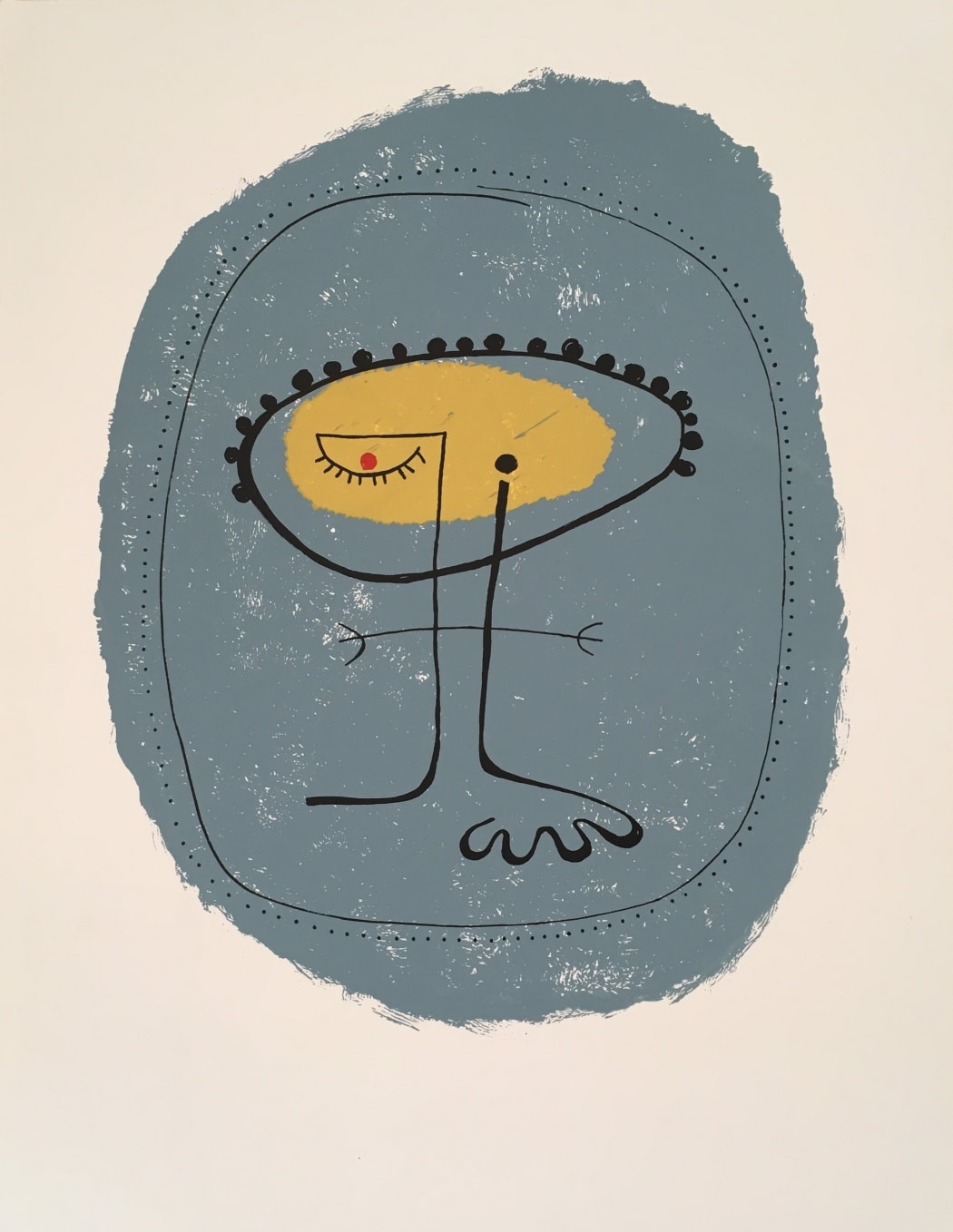 Victor Ekpuk The dancer, 2006 Lithograph on paper
Victor Ekpuk The dancer, 2006 Lithograph on paperAbstract African Art
A little more about abstraction in art from Africa and its diasporaThis article will explore the complexity involved in understanding abstract art from the continent and its diaspora and will give examples of artists who work well in this arena.
The influence of European colonialism played a significant role in shaping artistic perspectives in Africa and the diaspora. Traditional art forms, often characterised by figurative and symbolic representations, were sometimes marginalised in favour of Western artistic styles.
-

With different interpretations of personal and shared experiences as artists of Nigerian heritage, these emerging artists are restless and relentless in their exploration of issues relating to social, cultural, economic and political identity while reviewing the ideas of gender, sexuality, race, nationality and heritage. The Nigerian art scene continues to remain globally recognised as the works of these artists are pulling numbers in the art market.
Dominating the art scene in the last five years, Pavillon54 introduces 8 emerging artists you should know, look out for and support.
-
 Abstract art from the continent and diaspora, once on the fringes of the global art landscape, has now taken its rightful place in the spotlight. From the diverse community of African artists, we spotlight our picks of abstract artists, each with a unique voice, a different perspective, and an artistry that transcends borders. From Limpopo to Fort de France, their artistic journeys reflect personal narratives, socio-political commentaries, and cultural identity.
Abstract art from the continent and diaspora, once on the fringes of the global art landscape, has now taken its rightful place in the spotlight. From the diverse community of African artists, we spotlight our picks of abstract artists, each with a unique voice, a different perspective, and an artistry that transcends borders. From Limpopo to Fort de France, their artistic journeys reflect personal narratives, socio-political commentaries, and cultural identity. -
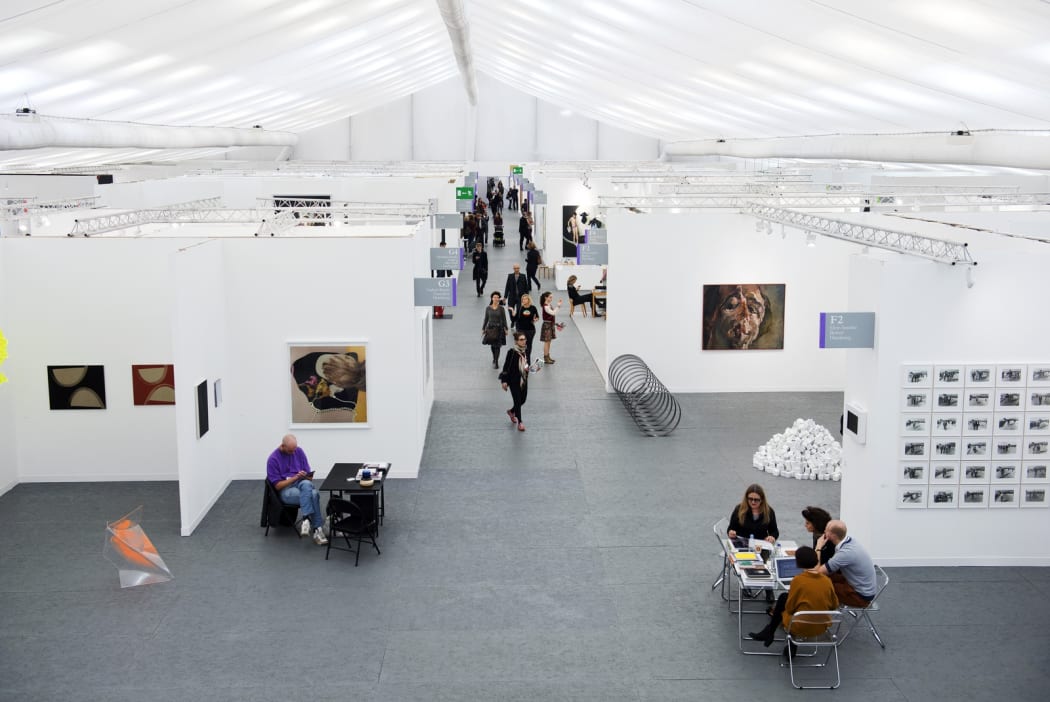 In the ever-evolving world of contemporary art, the latter part of the year 2023 promises to be vibrant, with exhibitions ongoing and visionary curatorship unceasing. As the art world gears up for a spectacular finale, we explore a curated selection of upcoming art fairs that will captivate aficionados, collectors, and enthusiasts alike. From London's iconic Somerset House to the sun-drenched shores of Miami Beach, and the heart of Paris, these art fairs bring together a rich tapestry of artistry and diverse art enthusiasts. Each event possesses its unique character, casting a spotlight on emerging talents, established masters, and the ideas that will shape the contemporary art landscape in the coming months.
In the ever-evolving world of contemporary art, the latter part of the year 2023 promises to be vibrant, with exhibitions ongoing and visionary curatorship unceasing. As the art world gears up for a spectacular finale, we explore a curated selection of upcoming art fairs that will captivate aficionados, collectors, and enthusiasts alike. From London's iconic Somerset House to the sun-drenched shores of Miami Beach, and the heart of Paris, these art fairs bring together a rich tapestry of artistry and diverse art enthusiasts. Each event possesses its unique character, casting a spotlight on emerging talents, established masters, and the ideas that will shape the contemporary art landscape in the coming months. -
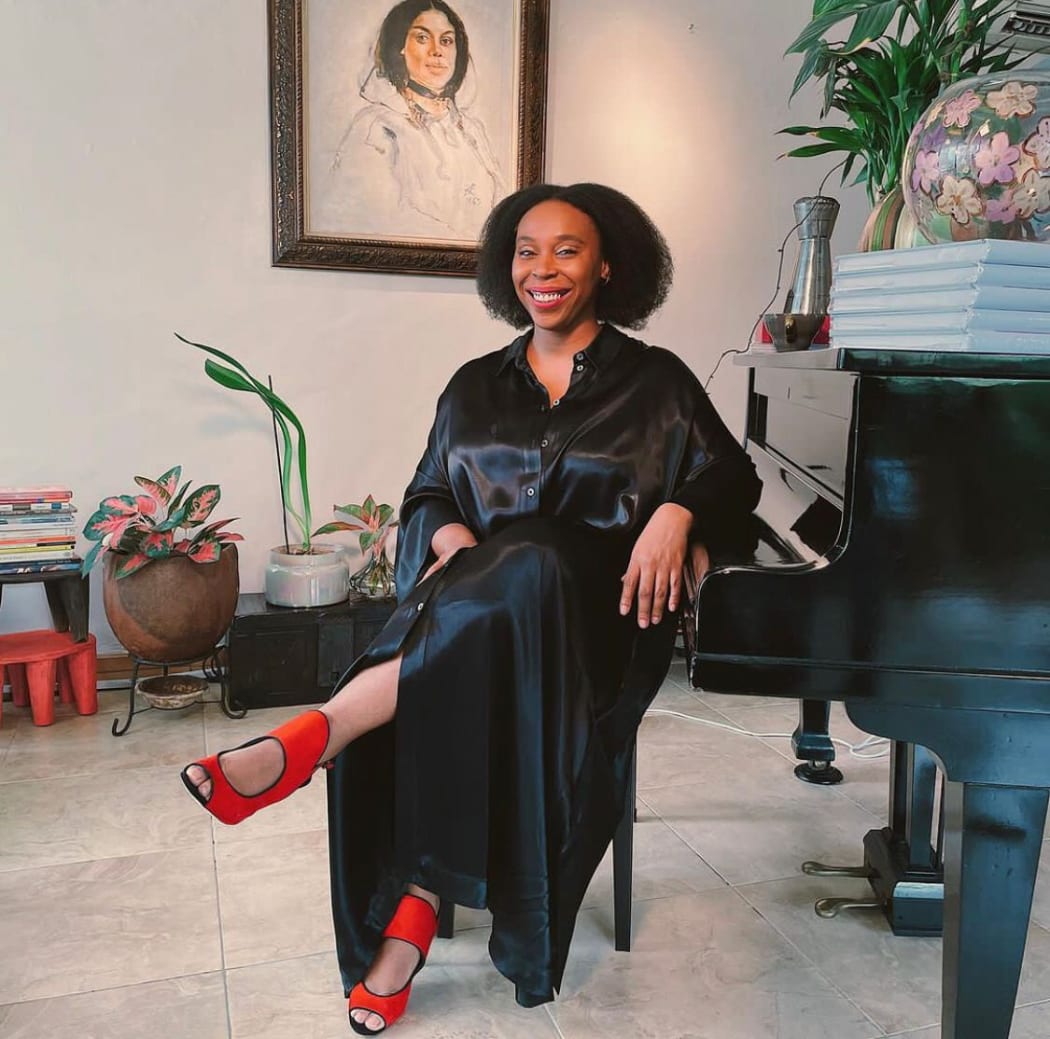
In this series, collectors are invited to open their art collections to Pavillon 54 readers.
Collector Ugoma Ebilah is one of the unusual suspects in the ever-booming Lagos art scene in Nigeria. A corporate finance professional turned creative entrepreneur, Ugoma is known for her community-building efforts and dynamic taste-making. She is the founding director and chief curator at Bloom Art, a portfolio gallery and private art salon set in the heart of Victoria Island.
-
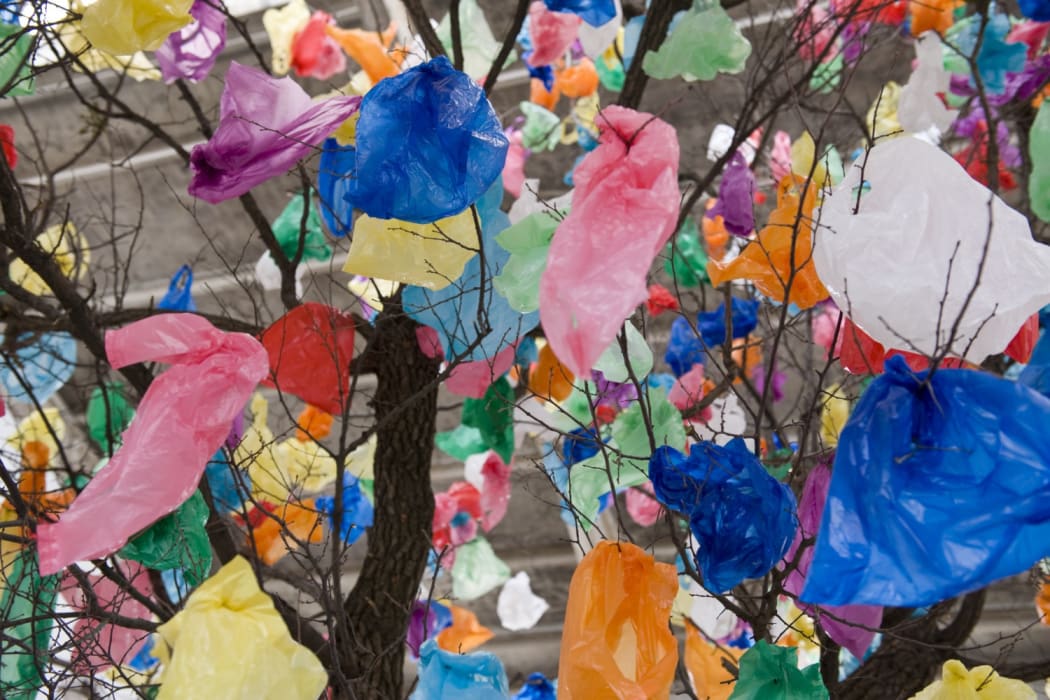
In an era marked by the far-reaching repercussions of climate change, Africa finds itself grappling with its profound ramifications, bearing a disproportionate burden due to its unique geographical positioning, economic complexities, and limited capacity. The continent is now grappling with an intensified frequency of droughts, floods, and other erratic weather patterns, compounding preexisting vulnerabilities and placing the livelihoods of countless individuals at stake. The imprint of climate change is starkly evident in disrupted agricultural systems, a precarious food security landscape, all while the intricate tapestry of biodiversity and ecosystems faces unprecedented jeopardy.
Amidst this crucible of challenges, an inspiring narrative unfolds as African artists step onto the forefront as catalysts for change. Harnessing creative expression, artists have embarked on a mission to spotlight the harrowing realities of climate change and kindle a call to action within both local communities and the global arena. Through their endeavours, African artists are not only thrusting the crisis to the forefront of collective consciousness but also underscoring the transformative potential of art as a potent instrument for driving societal metamorphosis. In this article, we round up a handful of artists across the continent who emerge to respond to the climate crisis.
-
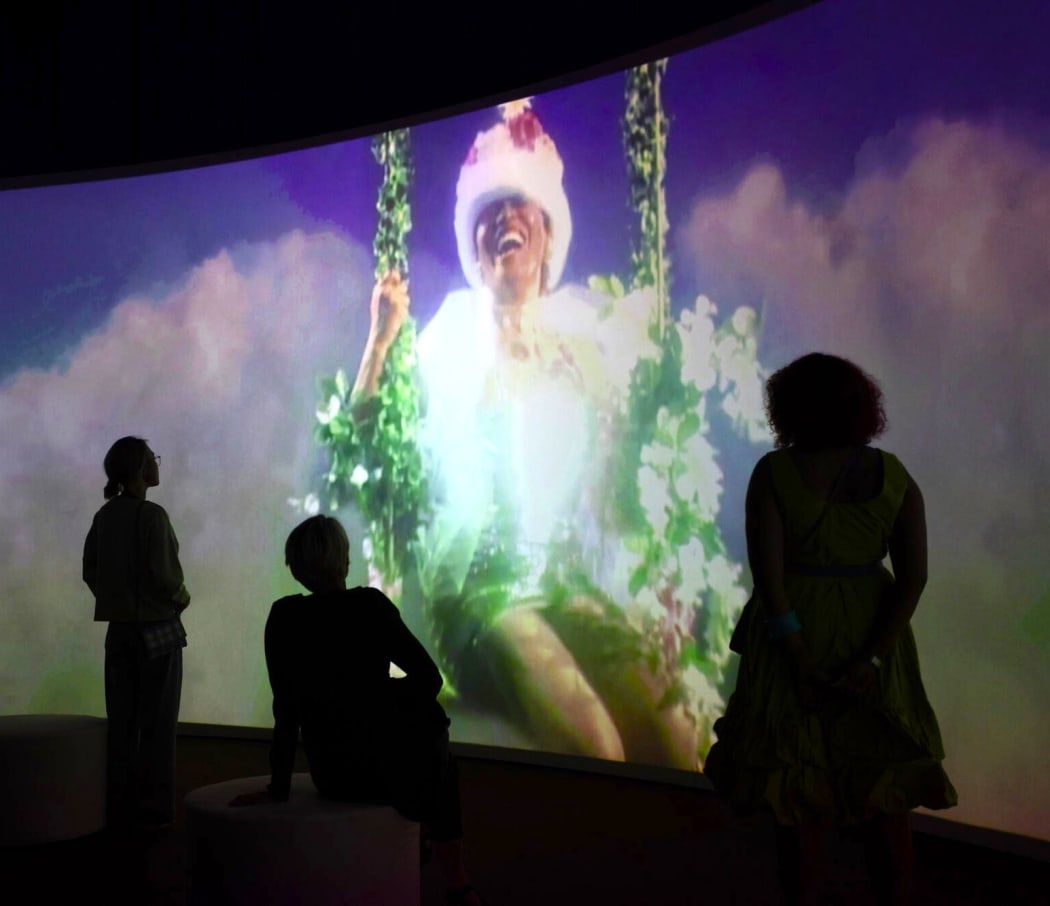 Summer has arrived in the Northern hemisphere and it is arguably the best time of year to enjoy the various offerings each city provides — architecture, parks, and undoubtedly the various museums and galleries. From iconic artists to rising stars, lesser known art movements and the celebration of African photography, this guide offers our picks on the ever-evolving landscape of contemporary art.
Summer has arrived in the Northern hemisphere and it is arguably the best time of year to enjoy the various offerings each city provides — architecture, parks, and undoubtedly the various museums and galleries. From iconic artists to rising stars, lesser known art movements and the celebration of African photography, this guide offers our picks on the ever-evolving landscape of contemporary art. -
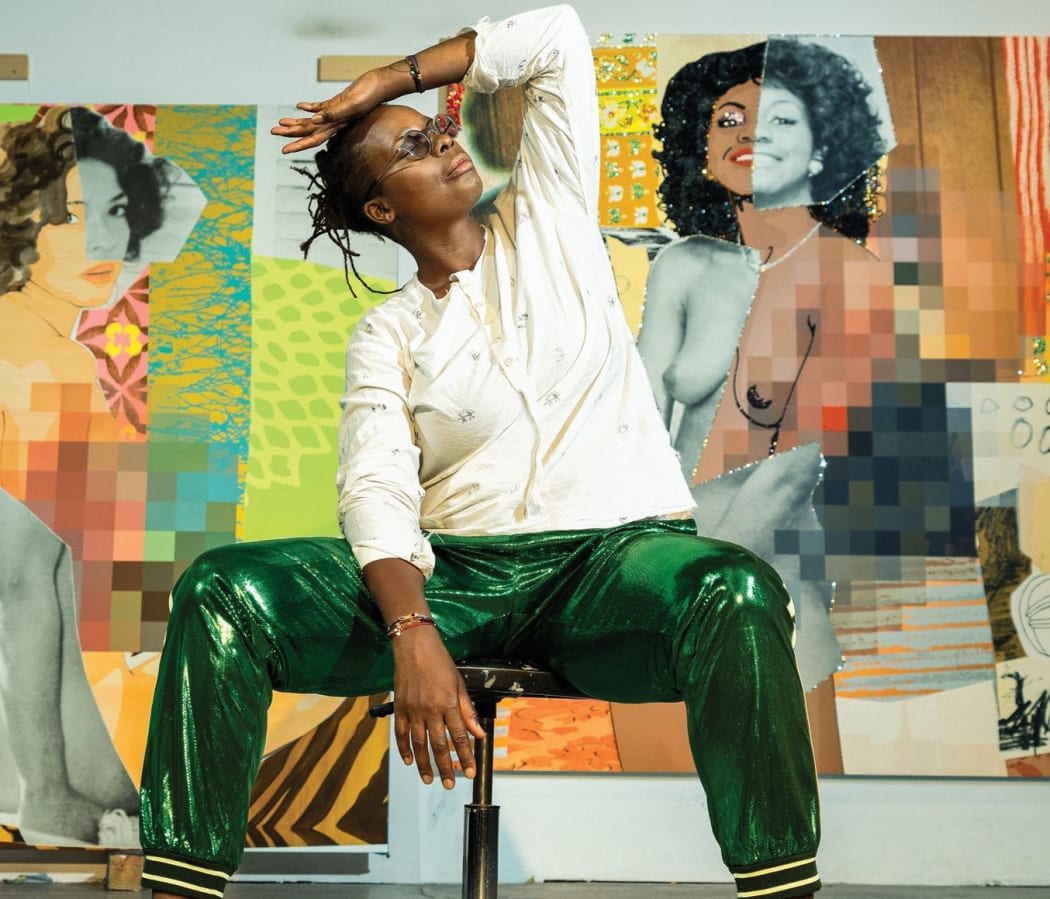 As Pride month comes to a close, it is crucial to recognise the artistic contributions of queer individuals who challenge traditional narratives and perspectives. In the realm of contemporary art, one name that stands out is Mickalene Thomas. With her bold reinterpretation of iconic works like Édouard Manet's Olympia and Le Dejeuner sur l'herbe, Thomas offers a unique representation from a black and queer perspective, simultaneously engaging with queer theory. In this article, we will delve into Thomas' artistic journey and explore how she reshapes the art world through her powerful and inclusive vision.
As Pride month comes to a close, it is crucial to recognise the artistic contributions of queer individuals who challenge traditional narratives and perspectives. In the realm of contemporary art, one name that stands out is Mickalene Thomas. With her bold reinterpretation of iconic works like Édouard Manet's Olympia and Le Dejeuner sur l'herbe, Thomas offers a unique representation from a black and queer perspective, simultaneously engaging with queer theory. In this article, we will delve into Thomas' artistic journey and explore how she reshapes the art world through her powerful and inclusive vision. -
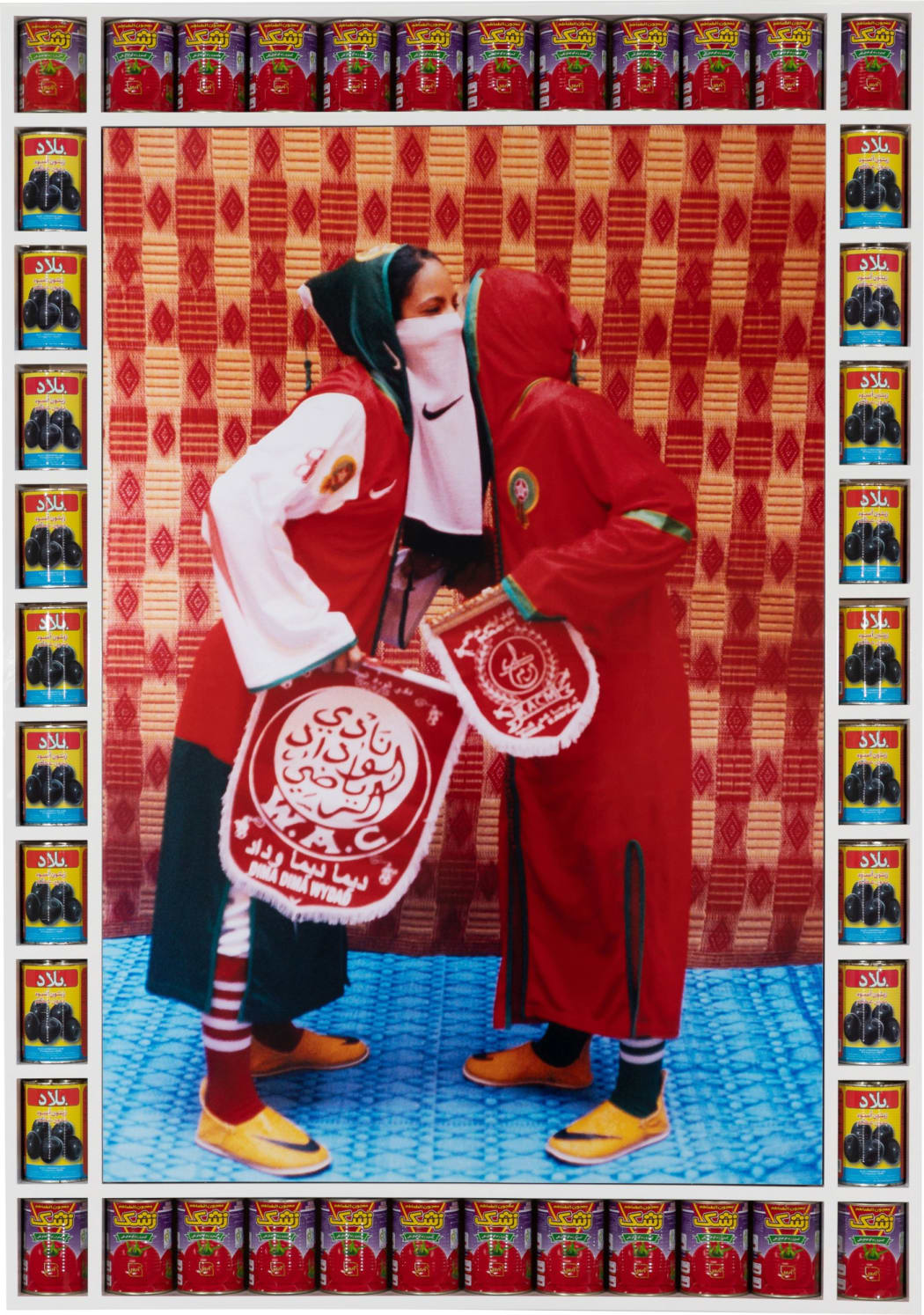
For Morocco, rich artistic heritage comes hand in hand with its traditional artisanship, colourful enclaves and impressively ornate architecture. In recent years, this creative identity has been added to by the growth of its contemporary art scene. Two major private institutions — Museum of African Contemporary Art Al Maaden (MACAAL) and Musée Yves Saint Laurent Marrakech — opened within two years of one another. Events like Marrakech Art Week and 1-54 Contemporary African Art Fair add to the growing excitement.
This roundup gathers together a list of artists from Morocco that is significant to the local scene and have made waves internationally. While many still live in Morocco, others work within the diaspora and present opportunities for international audiences to immerse themselves. Perhaps this roundup may even convince you to make plans to visit the country and discover the spaces and artists in the flourishing contemporary art scene.
-
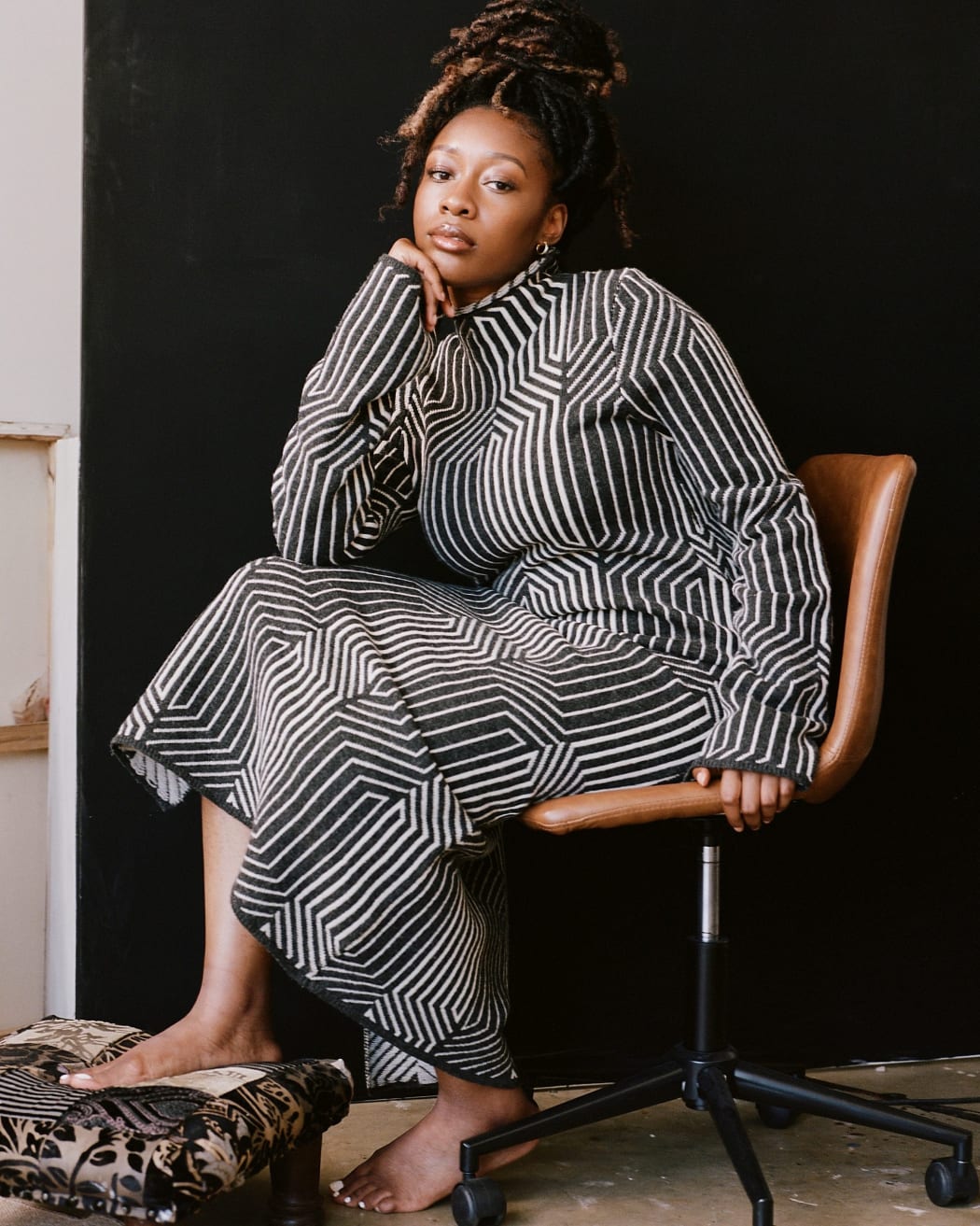
Ideas of the home have been explored in contemporary art — tied to issues of race and gender, identity and class. The ‘home is where the heart is’ theme is an abundant notion with many myriad approaches in contemporary art. In Emma Prempeh’s paintings, homes and interiors are imbued with locale, history, memory and identity.
Emma Prempeh is certainly an artist to watch — with much attention surrounding the artist there audiences can surely expect more.
-
 The annual Art Basel and UBS Art Market Report is out. With pages and pages of well-researched insights on the global art market from the previous year, the report covers topics from NFTs and online sales to auctions, dealers and fairs. It’s dense and certainly doesn’t qualify as light reading so here at Pavillon54 we break down some relevant findings from this lengthy 2022 report.
The annual Art Basel and UBS Art Market Report is out. With pages and pages of well-researched insights on the global art market from the previous year, the report covers topics from NFTs and online sales to auctions, dealers and fairs. It’s dense and certainly doesn’t qualify as light reading so here at Pavillon54 we break down some relevant findings from this lengthy 2022 report. -
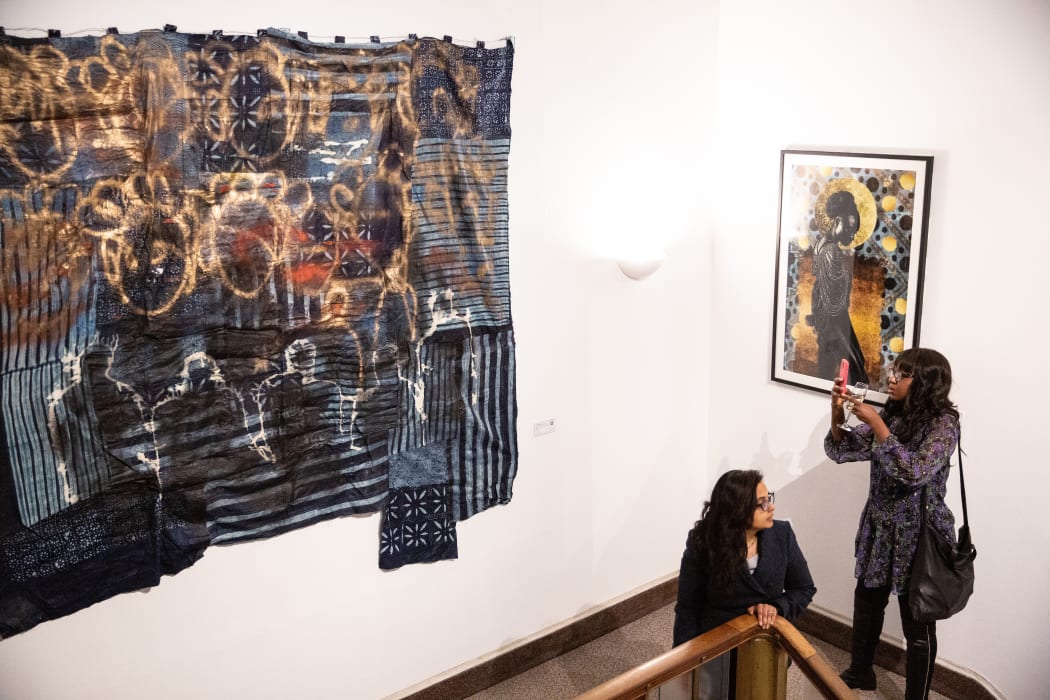
Black beauty, pride and excellence: A Tale of Reappropriation is all about representations of black culture and community. The product of a true collaboration between the Black in Business club at London Business School and Pavillon 54 from conception to the desinstallation. It’s no secret that during the course of history, Africans have been dehumanised and that the project of re-humanising the life and world of African societies remains an urgent task. The exhibition took a strong focus on finding more complex ways to critically engage with Black identities.
-
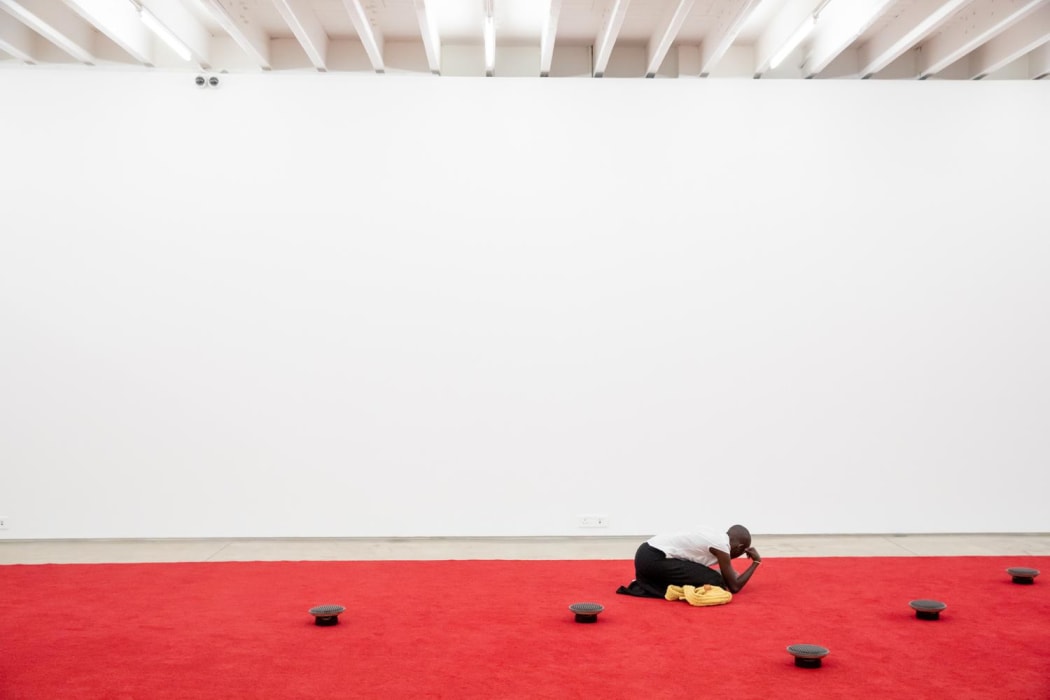
Celebrating a decade of contemporary South African art, Investec Cape Town opened its doors for its tenth edition. From modest beginnings, it is now generally acknowledged as the largest international contemporary art fair in Africa. The fair focused on the concept of time — the theme was broad, appropriately so as time is all-encompassing of ideas about the past, present, and future as well as the ever-important concept of change that comes with time. The tenth-anniversary timing for this theme was also appropriate. The fair reached its ten-year height, boasting 25 000 visitors, 106 exhibitors from 18 different countries, and 337 artists; it was the fair's largest-ever edition.
To accompany this larger-than-ever, birthday-bash edition, were some spectacular highlights that are worth celebrating especially because this fair has much to teach other fairs on the continent.
-
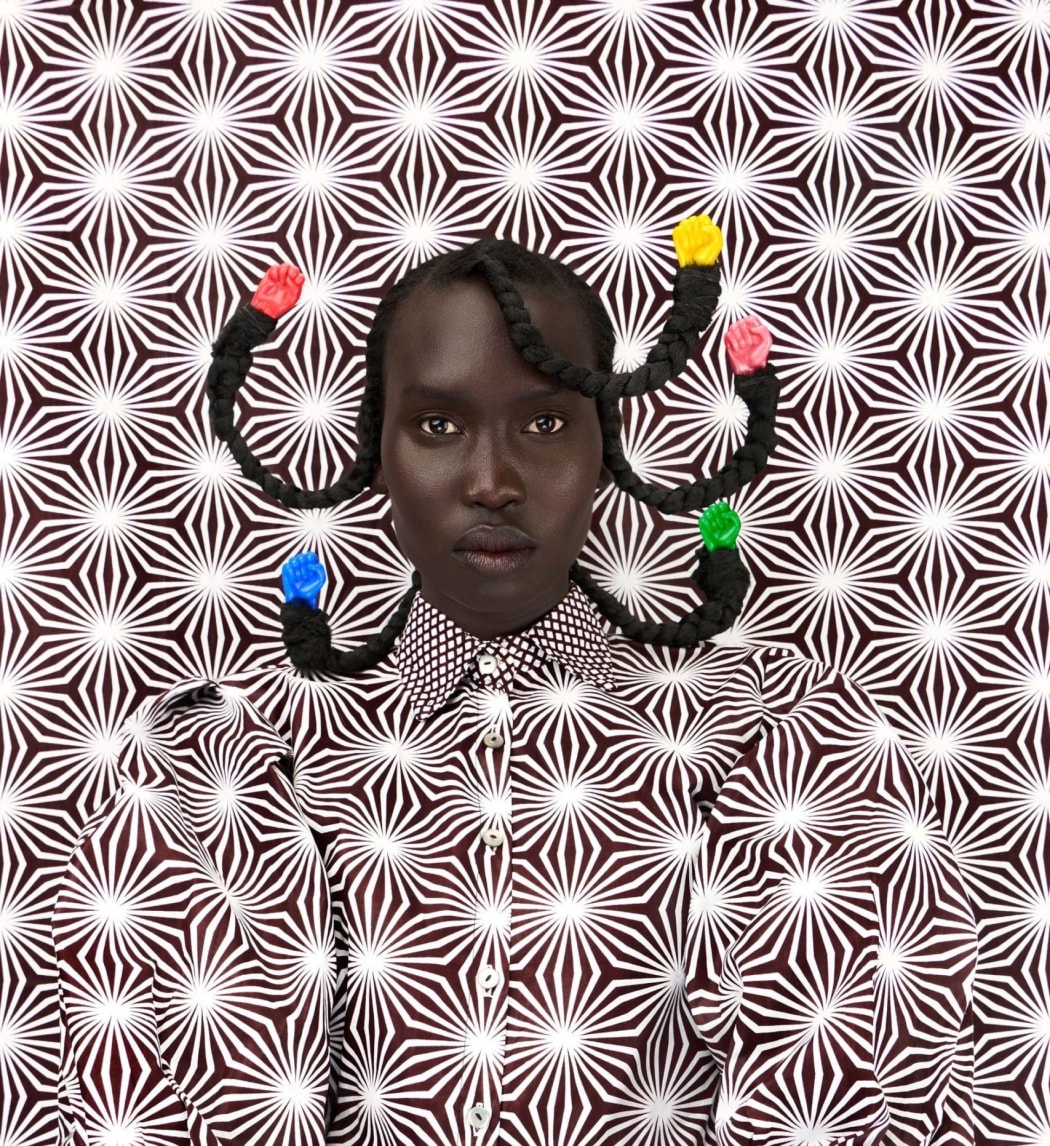
In recent years, Kenya has emerged as a key hub for contemporary art in East Africa. Nairobi is becoming an ever-more important hub for art in the region with a growing list of contemporary art spaces. These include the prominent Circle Art Gallery as well as GoDown Arts Center, Kuona Artists Collective, Nairobi Contemporary Art Institute (NCAI), and the One-Off Contemporary Art Gallery, to name a few.
Granted, the city has a smaller scene than other centres of contemporary art in Africa such as Lagos, Johannesburg and Cape Town, due to a number of significant setbacks such as insufficient galleries, schools and spaces to make and show art, as well as a lack of support from government. But though the Kenyan capital’s art market might be young, its artistic community is flourishing. After chronicling lists artists you should know in the Democratic Republic of Congo, and established artists in both South Africa and Nigeria we look east to Kenya.
The seven artists in this review do not form a comprehensive list by any means — it is a list of artists who are accessible and influential. Kenya is also home to renowned artists, Michael Soi, Boniface Maina, Michael Armitage and Wangari Mathangi among others.
-
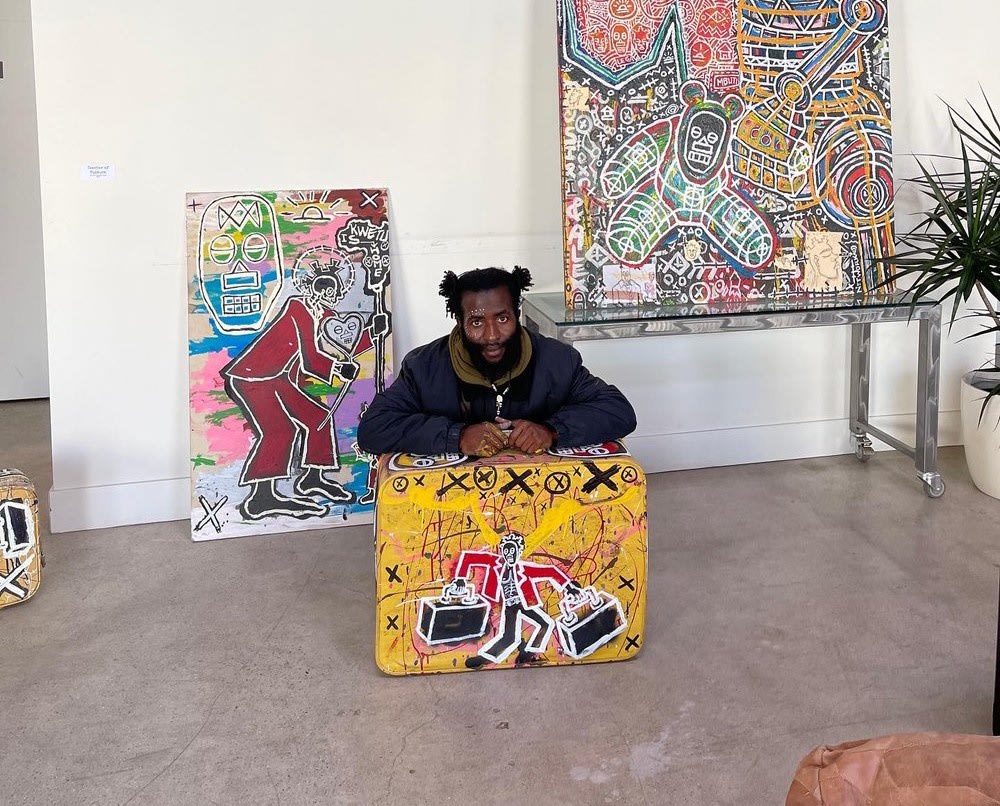
Bâ Simba speaks slowly, intentionally, and every word that comes from his brain seems to be hand-crafted and specifically selected for the sentence he wishes to convey. His words have a weightiness and authority that belie his humble nature, but they are well-suited to his body of work, a painterly practice that employs vivacious colour, strong line, and profound storytelling, in ample measure.
In an interview with the artist, Pavillon 54 asks Bâ Simba more about his practice, his inspirations, and the story he wishes to convey through his art.
-
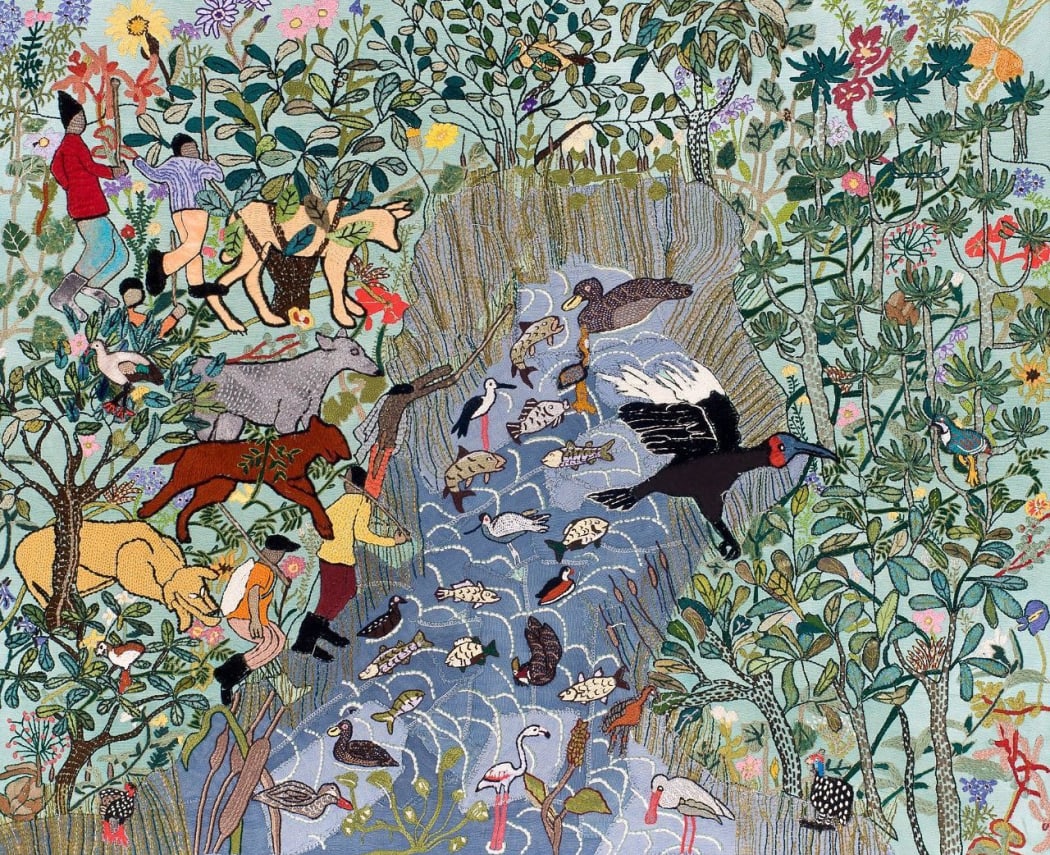
What is defined as textile art is art that uses varying materials and fibers to produce decorative, artistic objects. It’s one of the oldest forms of art in history and has played a part in practical and decorative man-made objects for hundreds of thousands of years. Across the African Continent, textile art has played a huge role in reflecting the individual cultures and styles of specific countries and areas.
Nowadays, many contemporary artists are weaving together a rich variety of textile art in new ways. This list, which is in no way complete, offers a taste of what contemporary artists working in the medium offer.
-
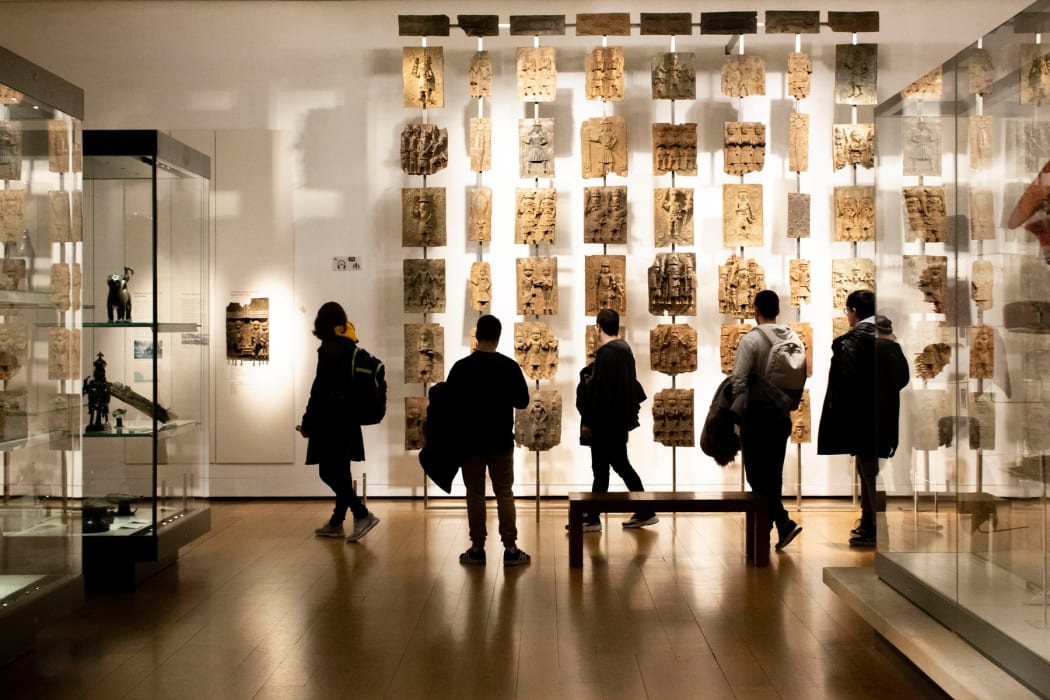
If you’ve been reading our art market coverage of the African Art Market in articles such as our African Art Market Report 2021 or our ‘Break down of the African Art Market,’ you’ll know that African art sales maintained healthy volume and growth last year. Despite the total restructuring of the global art market due to the COVID-19 pandemic, galleries and art organisations in Africa managed to stay afloat for the most part, and have made a vigorous comeback with art fairs, gallery shows and a growing collectorship on the continent adding to the market’s success. But how has the African art market fared so far in 2022? We provide the key insights from the first half of this year below.
-
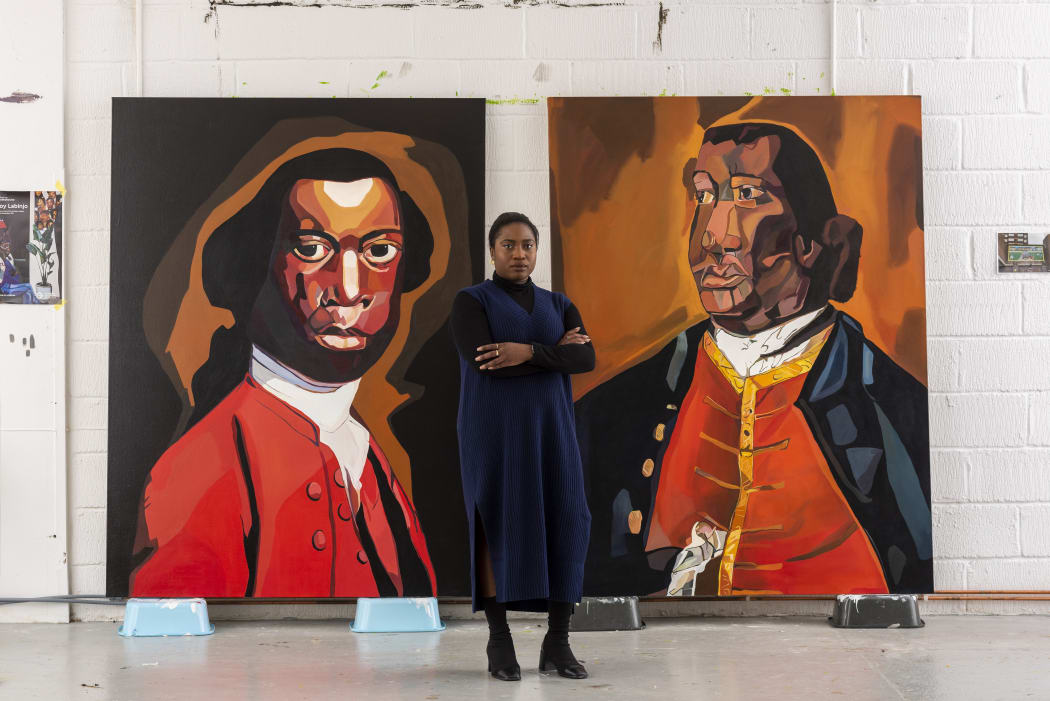 Lovers, collectors and dealers of African art have a new rising star to keep their eyes on: Joy Labinjo. The British-Nigerian artist, who paints large-scale figurative paintings, often of black individuals, has leapt to rapid success in recent years, known for her talent in capturing sensitive, independent, contemplative, and vulnerable people — sometimes all in one.
Lovers, collectors and dealers of African art have a new rising star to keep their eyes on: Joy Labinjo. The British-Nigerian artist, who paints large-scale figurative paintings, often of black individuals, has leapt to rapid success in recent years, known for her talent in capturing sensitive, independent, contemplative, and vulnerable people — sometimes all in one. -
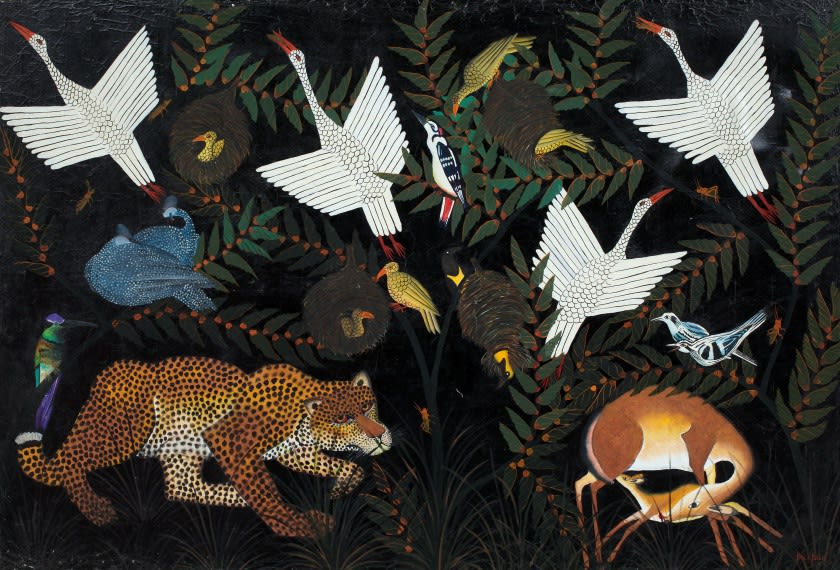
To navigate the history of art of a complex, multifaceted and multicultural continent as Africa, especially if you just got passionate about it, can seem like an overwhelming maze. But no worries, we are here to help you. Follow our series of “Artists you should know or watch” in each country, and you could soon almost sound like an expert! After Nigeria and South Africa, let’s keep on with the Democratic Republic of Congo. In this article, we are looking at modern Congolese artists who have been mainly influential during the second half of last century.
-
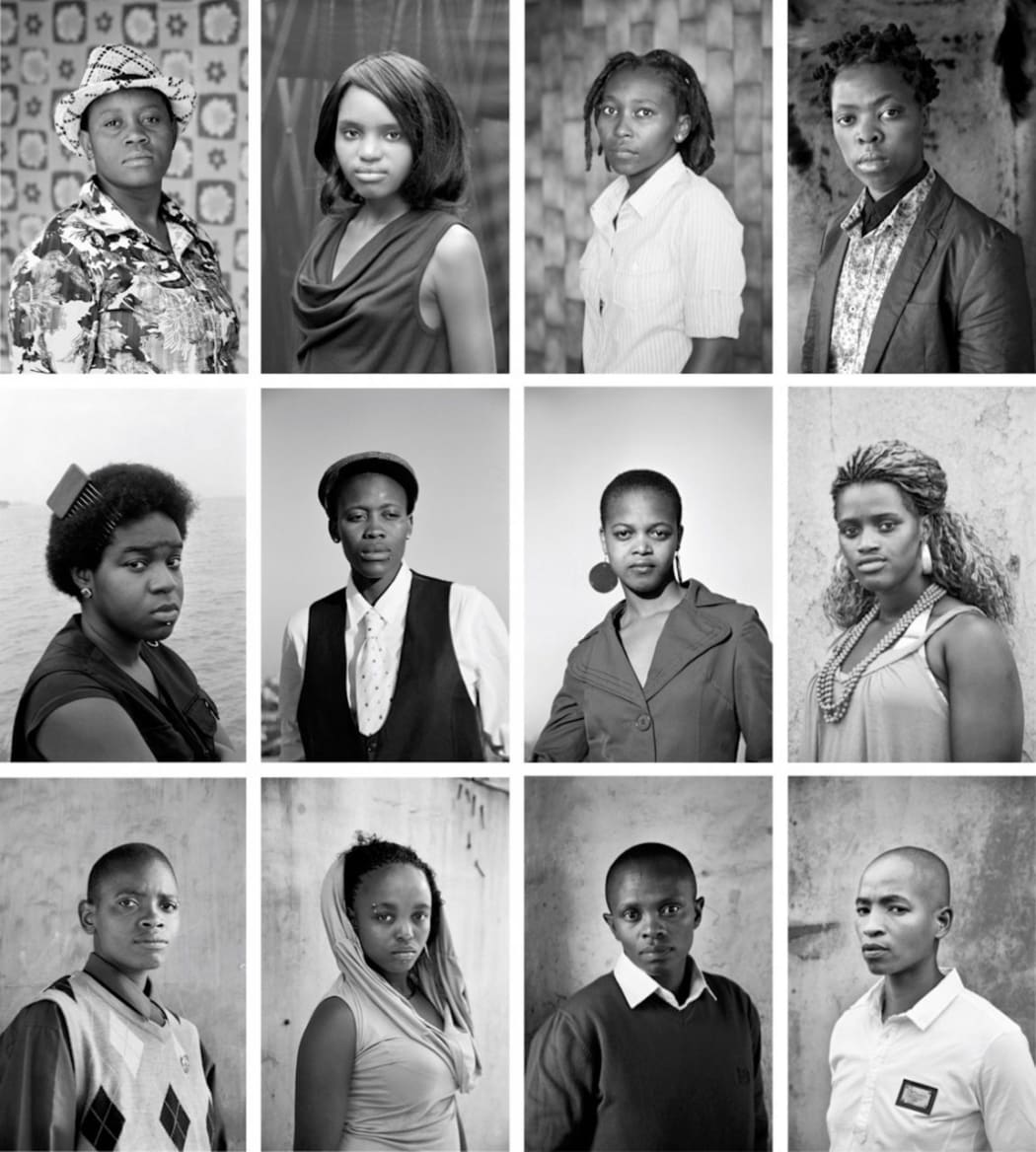
As Pride Month comes to a close, Pavillon54 highlights five key artists from Africa and the Diaspora who are defying cultural and societal expectations and furthering a progressive, forward-thinking and revolutionary African art movement. Through photography, performance, painting or sculpture—whichever weapon of choice the artists’ choose—each of their practices are dedicated to fighting stereotypes and discrimination against the queer communities in their respective countries, and the world more broadly. Read on to discover the methods in which these artists and activists use art to bring to light the pain, vulnerability, strength and beauty of queer individuals in Africa and beyond.
-
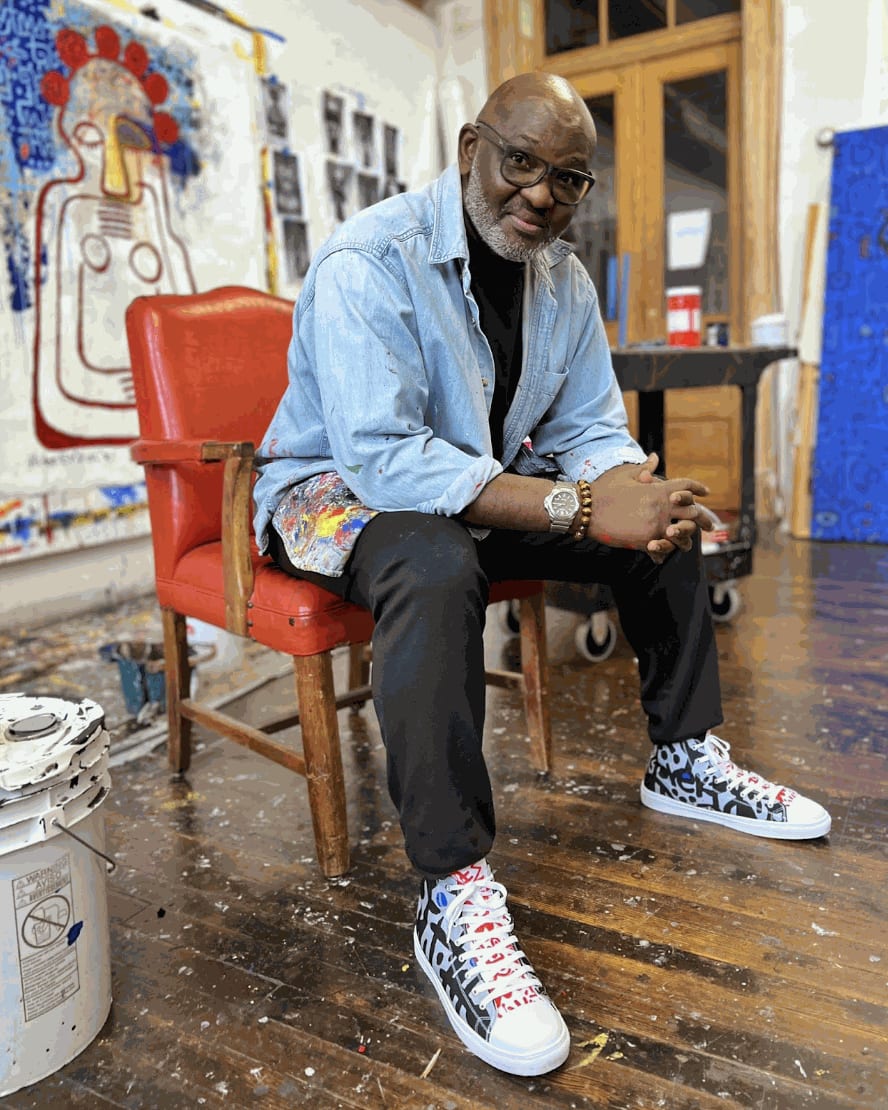
Nigerian-American artist Victor Ekpuk has come to acclaim through his unique visual language, which abstracts the ancient Nigerian script Nsibidi and indigenous Uli art forms. By taking these codes and philosophies as the base for his artistic practice, Ekpuk creates his own symbolism that aims to decrypt the truths of the human condition, placing particular focus on the contemporary African diaspora. Through his paintings, drawings and sculptures, Ekpuk’s language is instantly recognisable, with strong use of intricate linework and bold colour bearing the hallmarks of this signature. Through deep research into the philosophy of Nsibidi script, which the artist studied during his Bachelor of Fine Art at Obafemi Awolowo University in Nigeria, Victor Ekpuk’s work borders drawing and writing, furthering the concept of art being an inherently communicative and story-telling medium.
-
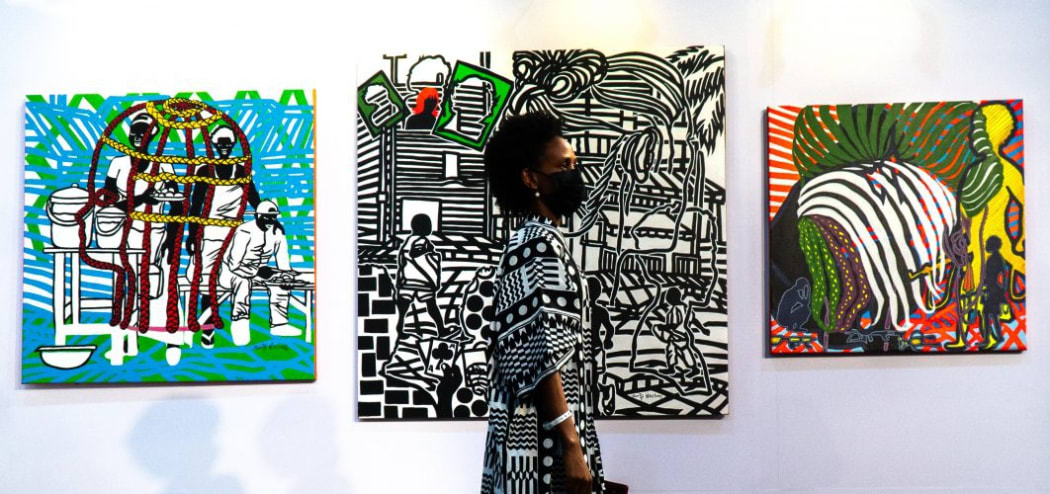
Through yet another unusual year after COVID-19 has been introduced into our lives in 2021, the art market as a whole has experienced incredible innovation and a steady comeback after the events of 2020. But how does the impact of artists from Africa and the diaspora fit into this narrative? Pavillon54 provides a breakdown of this year’s major events, and what we can look forward to for the second half of 2022.
-
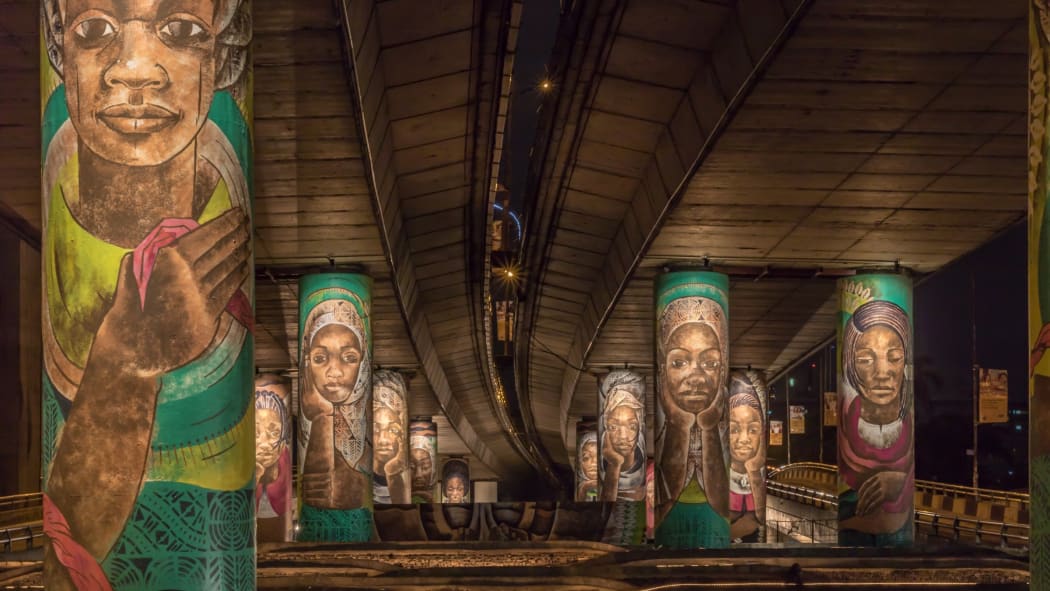 Oluwarantimi by Polly Alakija, public art project commissioned by Lagos Government. Photo @Tayo Adeoye
Oluwarantimi by Polly Alakija, public art project commissioned by Lagos Government. Photo @Tayo AdeoyeAs the second in our series of not-to-miss art destinations when scoping out the art scenes in Africa, we turn to Lagos, one of the leading art capitals on the continent. Lagos boasts a strong artistic tradition. When higher educational institutions were introduced into the country during the 1950s, Nigerian artists began to undermine traditional European-style painting by combining African artistic traditions in their practice, creating a distinct identity. Today, Nigeria hosts one of the largest art fairs on the continent and is home to numerous galleries and cultural institutions. The Pavillon 54 team recently had the privilege of visiting Nigeria and have compiled this list of must-see art spots in its capital city of Lagos.
-
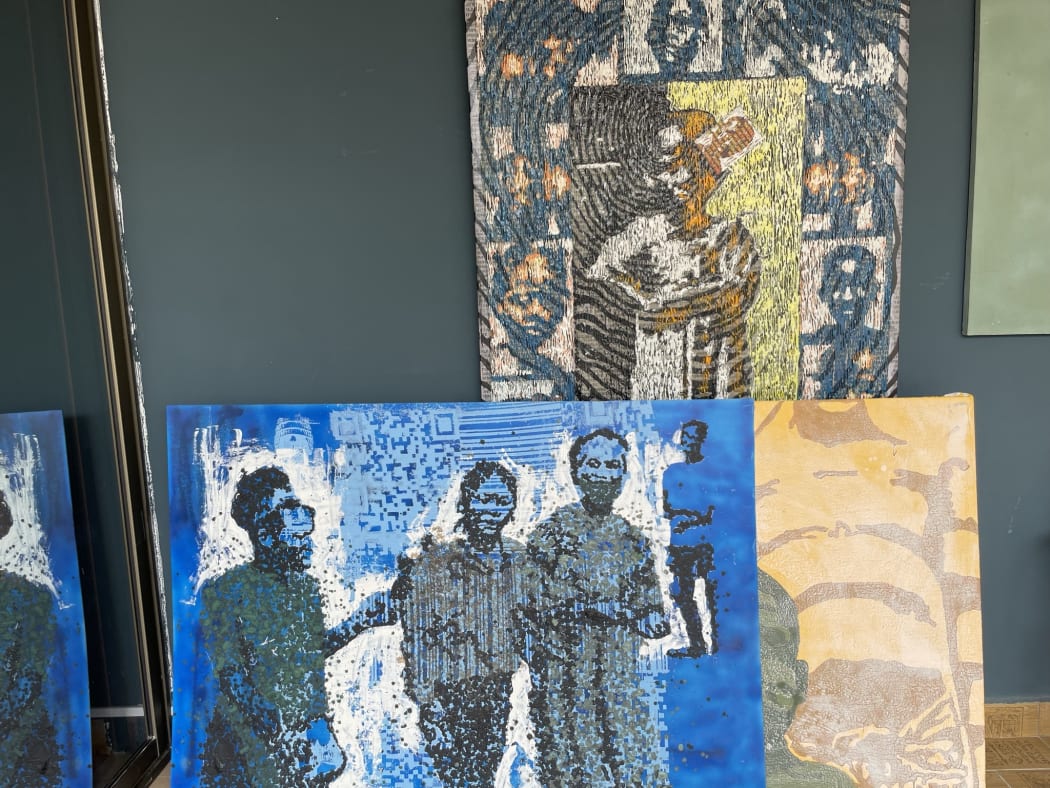 Saint-Etienne Yeanzi's Studio, 2021.
Saint-Etienne Yeanzi's Studio, 2021.Pavillon 54 had the chance to have a chat with Saint-Etienne Yeanzi. born in 1988, he graduated in painting and photography at the “ Lycée d'Enseignement Artistique “of Cocody and the National School of Arts in Abidjan, in 2012.
Yéanzi, a street art enthusiast, worked as a commissioned portrait painter for ten years. Since 2013, he has been pursuing personal work using melt plastic material. As many other African artists, he doesn’t create such pieces with the intention of becoming ‘Environmental’ artists, but rather, he uses the materials around him as a part of his existing culture and makes a more poignant statement about the effects of capitalism, as well as Western colonialism and consumerism on the African continent. Watch the video of the interview.
-
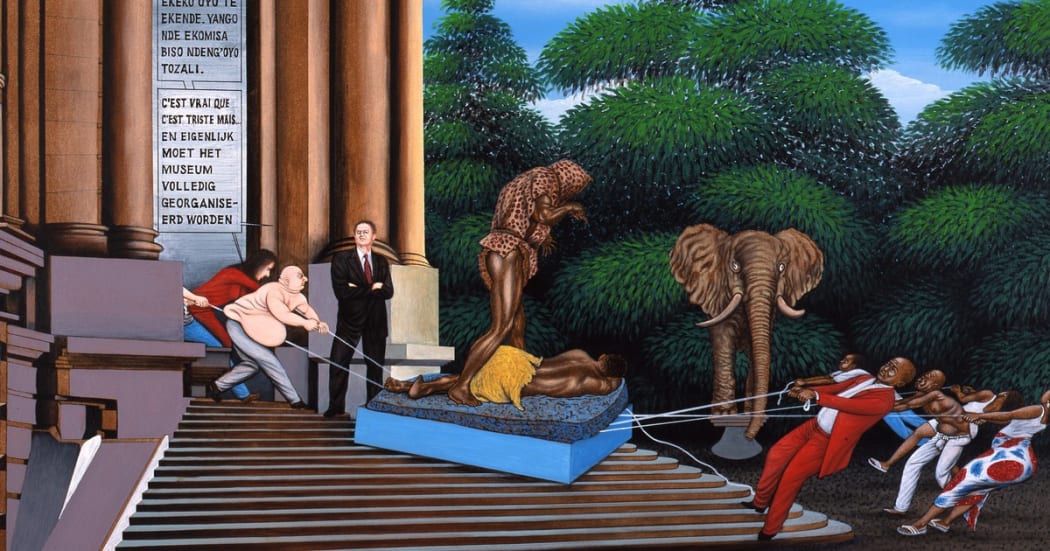 Chéri Samba’s ‘Réorganisation’ (2002), depicting a tug of war on the museum steps © RMCA
Chéri Samba’s ‘Réorganisation’ (2002), depicting a tug of war on the museum steps © RMCAZaire School of Popular Painting
African Modern and Contemporary Art movements: an insight.The influence of colonialism on African art was, for many years, an obstacle to an interpretation of the continent's own history of art. In this series we want to talk about the independent creative expressions framed in each of Africa's national cultures, histories and social-political contexts, with their own styles and artistic movements.
-
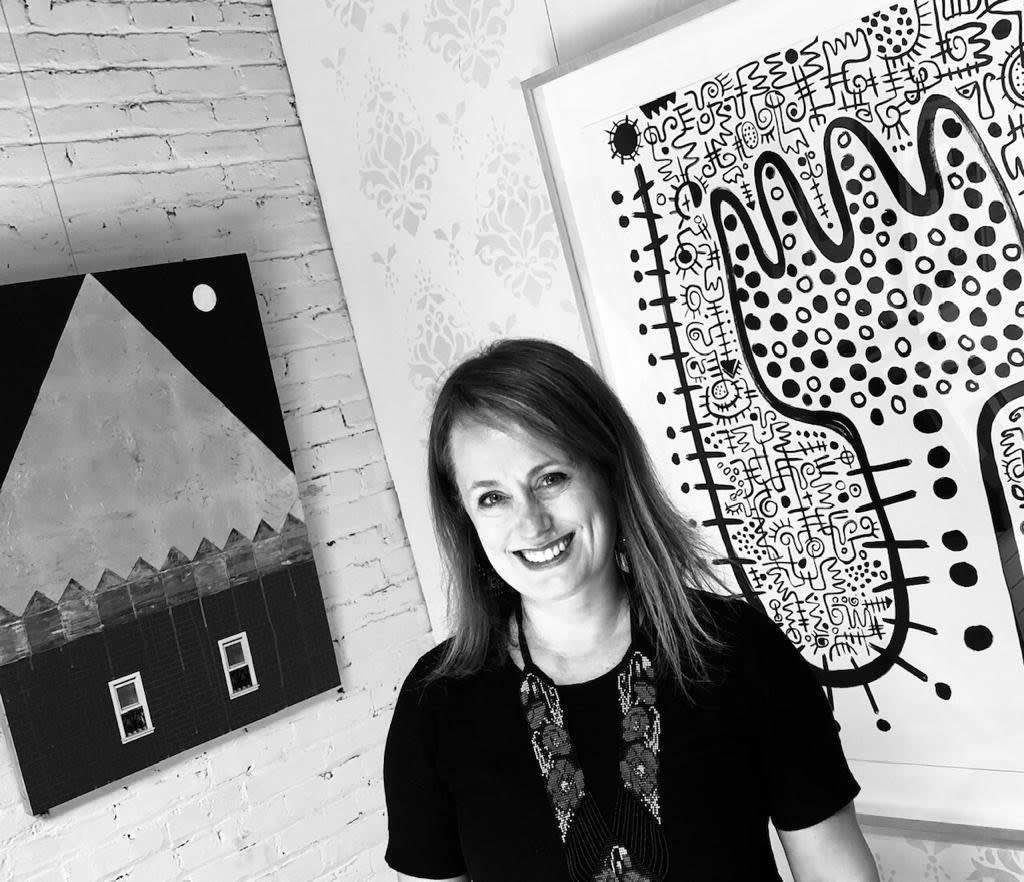 Amy Morton at Morton Fine Art gallery
Amy Morton at Morton Fine Art galleryAs the one-stop global digital platform and community for art from Africa and the Diaspora, Pavillon54 always seeks to enter fruitful partnerships with artists, curators, collectors, and galleries. It became only natural, then, that for the next step of our development, we partnered with some of the most exciting international galleries that specialise in contemporary African art and share our vision for the African art market.
-
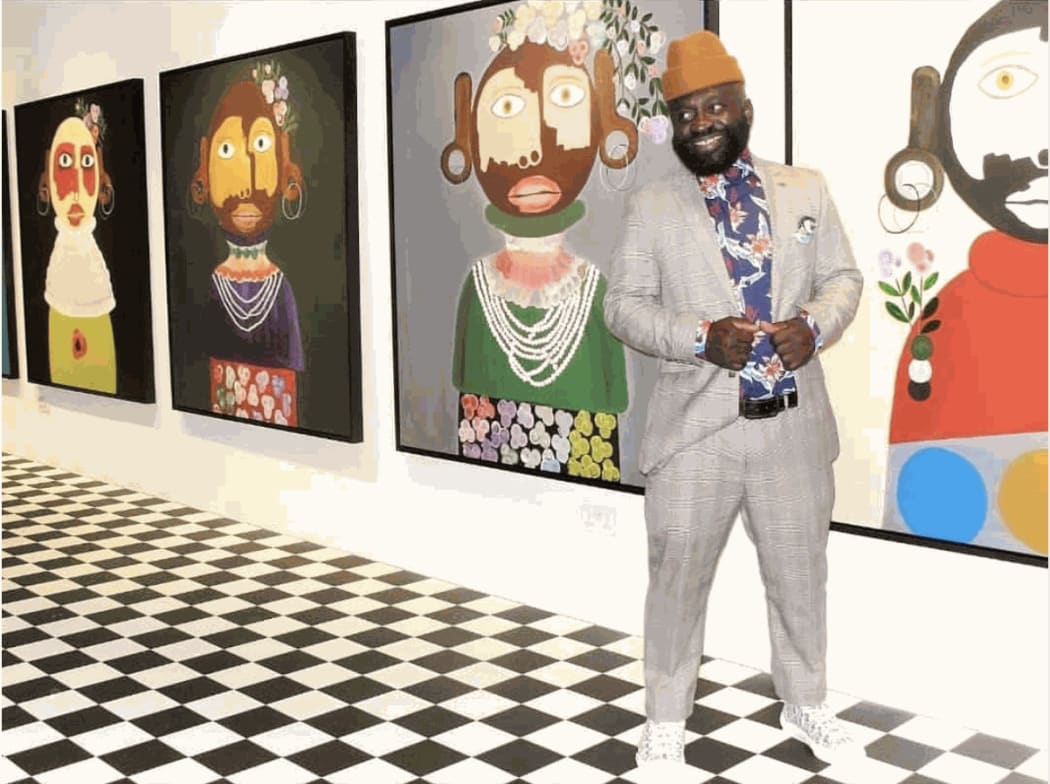 Solo exhibition "Dreaming of Identity' at JD Malat Gallery - from June 10th to July 17th
Solo exhibition "Dreaming of Identity' at JD Malat Gallery - from June 10th to July 17thKojo Marfo’s ‘Dreaming of Identity’
artworks to create a connection with people, to be a symbol for everyone to relate toWith his first solo UK exhibition ‘Dreaming of Identity’ at JD Malat gallery, London, Kojo Marfo (b. 1980) explores the theme of identity through his own experience of migration. The artist depicts human figures with references from Africa, representing his roots in Ghana and Akan’s culture, and from the Western world - representing his travel to New York in the 1990s and his life based in London from 1999.
-
 © Greatjoy in his studio, South-Africa
© Greatjoy in his studio, South-AfricaMeet Greatjoy: a “Contemporary expressionist”
Artists' Spotlight Series - Conversation with the artistPavillon 54 had the chance to have a chat with Greatjoy Ndlovu: born in 1993, Greatjoy is a Zimbabwean visual artist living and working in Johannesburg, South Africa. One of the most interesting emerging artists on the South African scene, Greatjoy dynamic paintings are enriched by expressive brush strokes, graphite-drawing and splashes of color. His subject matter is mostly focused on human beings: their bodies, their behaviour, and their emotions. During the past year, Greatjoy explored the impact of the pandemic on our society and created a series of works, displayed on Pavillon 54, focusing on subjects as love, affection and family.
-
 Credits: Nil Gallery, Prince Gyasi 'Dreaming With Attitude' (2021)
Credits: Nil Gallery, Prince Gyasi 'Dreaming With Attitude' (2021)New-York hosted two art fairs at the end of spring: Frieze New York & 1-54 New York. With fairs and other arty events progressively reopening their doors to the public – much of the display and outreach still took place online. Online viewing rooms or platforms and talks are your co-hosts of choice. What have been this year highlights
-
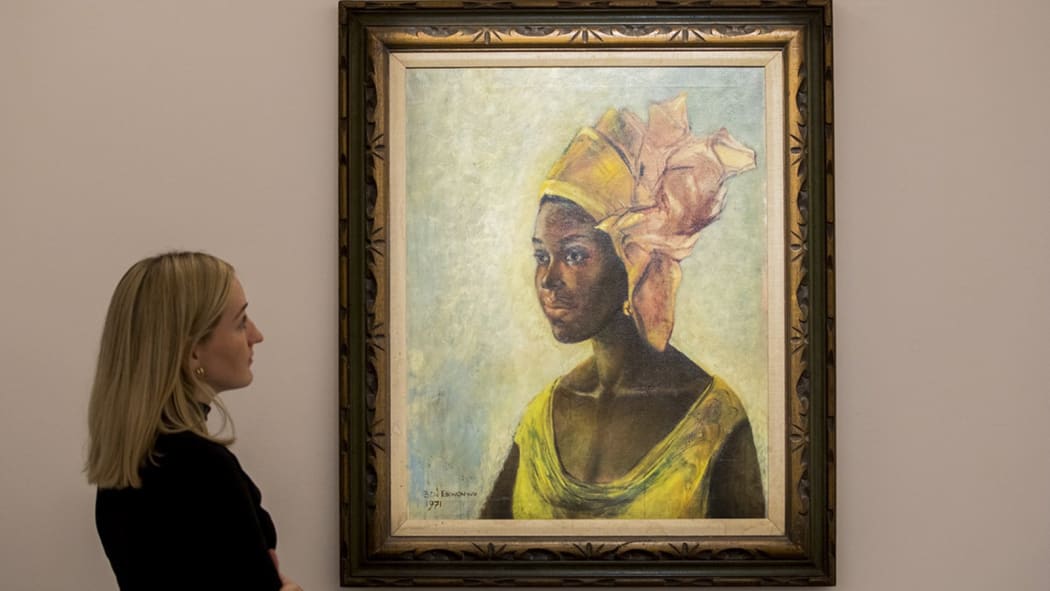 Ben Enwonwu's 'Christine' on view at Sotheby's on October 12, 2019, in London, England. Tristan Fewings/Getty Images for Sotheby's
Ben Enwonwu's 'Christine' on view at Sotheby's on October 12, 2019, in London, England. Tristan Fewings/Getty Images for Sotheby's7 Established Nigerian Artists You Should Know
Art scene in Nigeria - Country FocusTo navigate the history of art of a complex, multifaceted and multicultural continent as Africa, especially if you just got passionate about it, can seem like an overwhelming maze. But no worries, we are here to help you. Follow our series of “Artists you should know or watch” in each country, and you could soon almost sound like an expert!
In the past decade, Nigeria's art scene has gained independence and global recognition and has flourished, leading to a renewed interest in modern and contemporary art in the country. Here we list just 7 of Nigeria's most influential artists that one should know, this list is not exhaustive and could probably include many more artists. But we hope it will inspire you to research more about this lively and booming art scene!
-
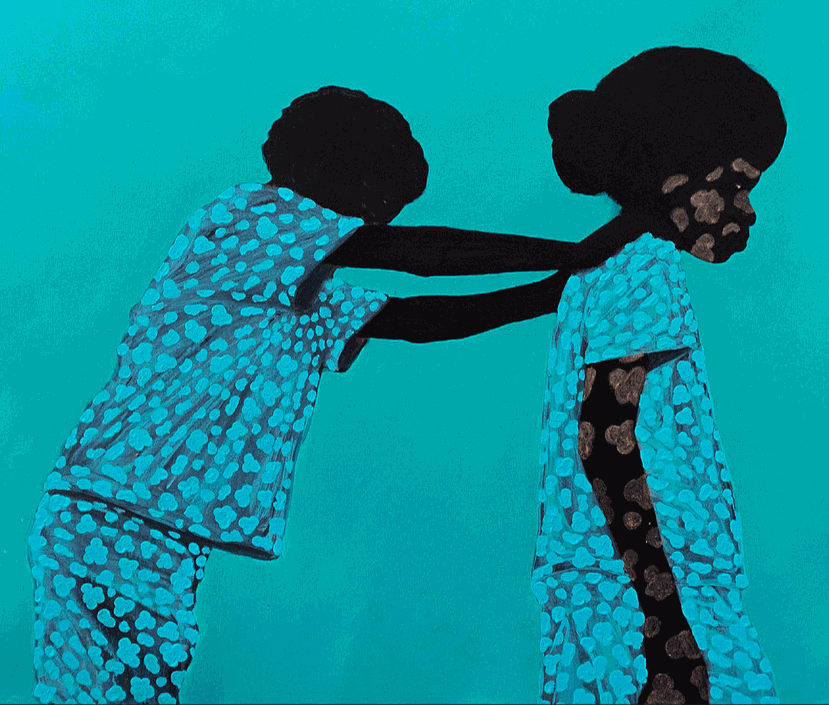 © Wonderbuhle 'Asikafiki', 2020, Acrylic and metallic paint on canvas, 100 x 100 cm
© Wonderbuhle 'Asikafiki', 2020, Acrylic and metallic paint on canvas, 100 x 100 cmThe late exhibition Liminality in Infinite Space held at the African Artists’ Foundation in Lagos has revealed much of contemporary African art’s appeal for figuration and portraiture – catalogue accessible here. The show’s intention seems to be twofold. First, “this exhibition arches back to more traditional art-making practices including painting, collage, tapestry and woodcuts”. Secondly, and from a representation standpoint, “it intentionally moves away from exaggerated depictions of blackness towards sharing moments of vulnerability and unostentatious joy”. It is no surprise at a time in which the black body is subjected to all sorts of gaze, subjugation, aggression or praise.
-
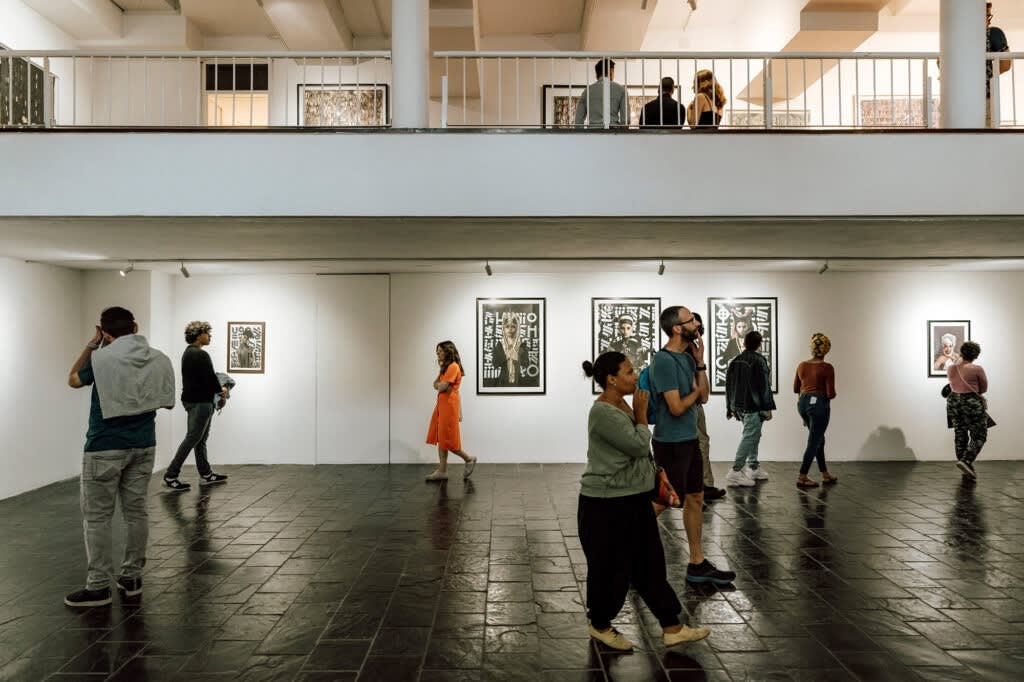 One of the galleries open on First Thursday, downtown Cape Town © travel.sapeople
One of the galleries open on First Thursday, downtown Cape Town © travel.sapeopleOne of Pavillon 54’s favourite things to do is to physically visit and scope out the artistic scene in various countries in Africa. This has been hard to achieve during the pandemic, however we fortunately managed to visit South Africa recently, and have already compiled a list of the 7 emerging artists to watch there. In this next instalment of our series on the art scene in South Africa, we highlight the 7 top art destinations in South Africa that every art lover has to experience.
-
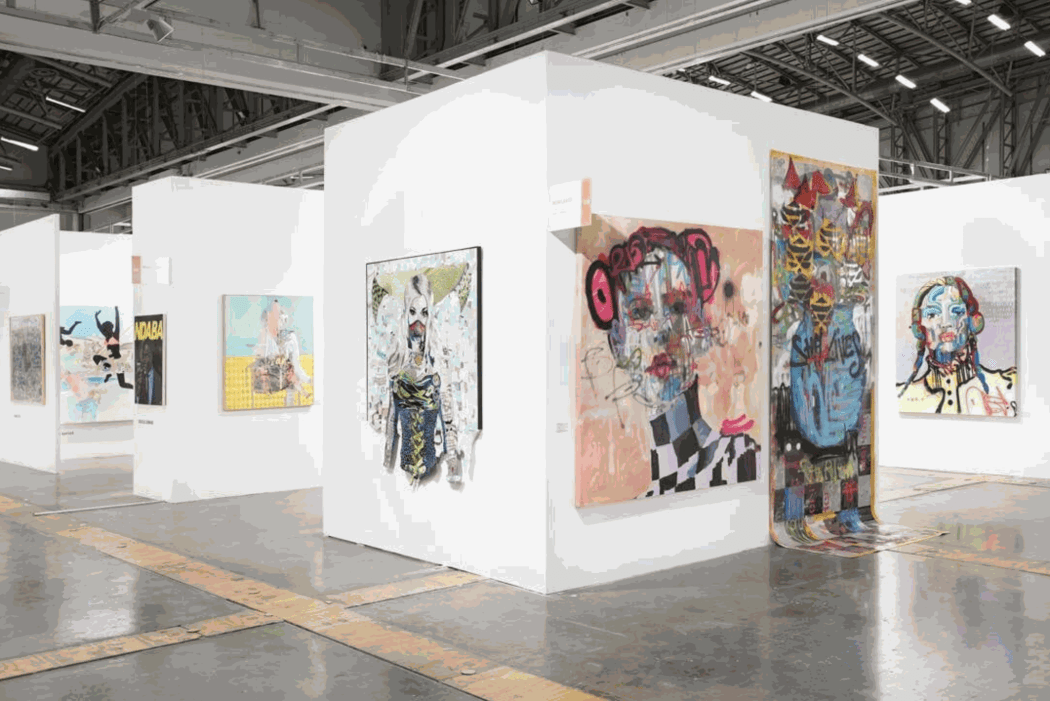 The Investec Cape Town Art Fair 2020
The Investec Cape Town Art Fair 2020 -
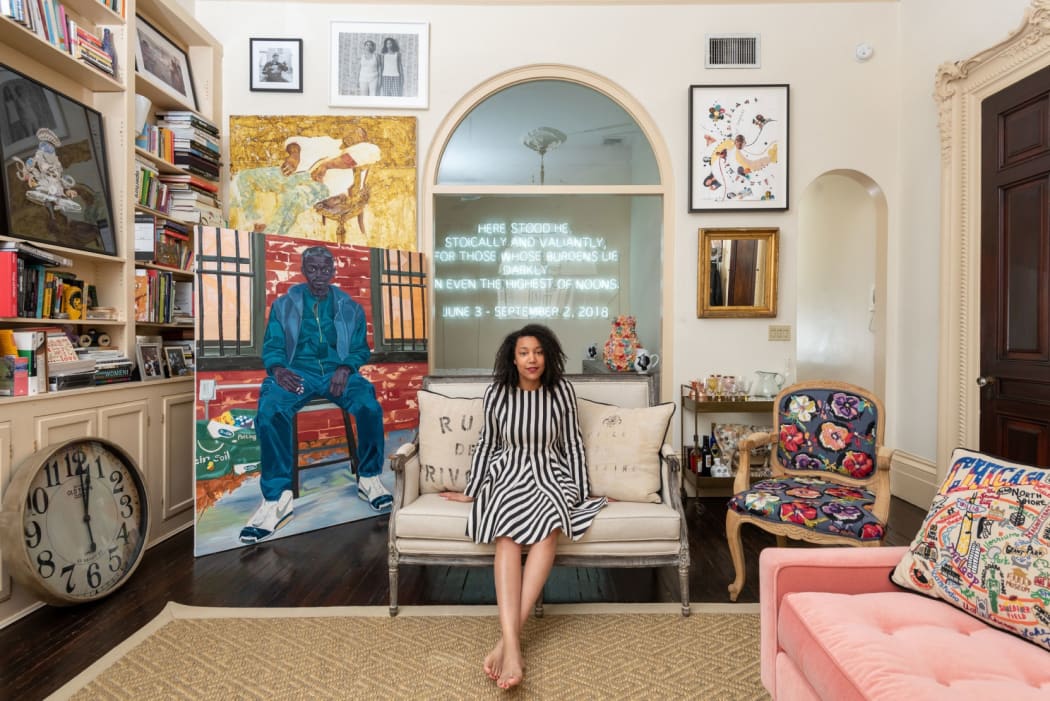 Victoria Rogers for CULTURED MAGAZINE [1] © CHRIS WAGGONER
Victoria Rogers for CULTURED MAGAZINE [1] © CHRIS WAGGONEROne of the biggest misconceptions about collecting art is that you must be very wealthy to do so. However, this is simply not the case, as there are plenty of emerging artists and art markets to invest in at affordable prices. Art from Africa and its diaspora is one such example, as its market is still developing rapidly. Collectors can obtain artworks of great quality and investment value at lower prices, and therefore not only contribute to the growth of an incredible movement of artists, but also add an artwork to their collections that is expected to grow in value.
But diving into the art world and the art market can be a mammoth task. What are the best ways to begin your forays into the art world without breaking the bank, and where can you start? We list some of our top tips for starting an art collection on a budget.
-
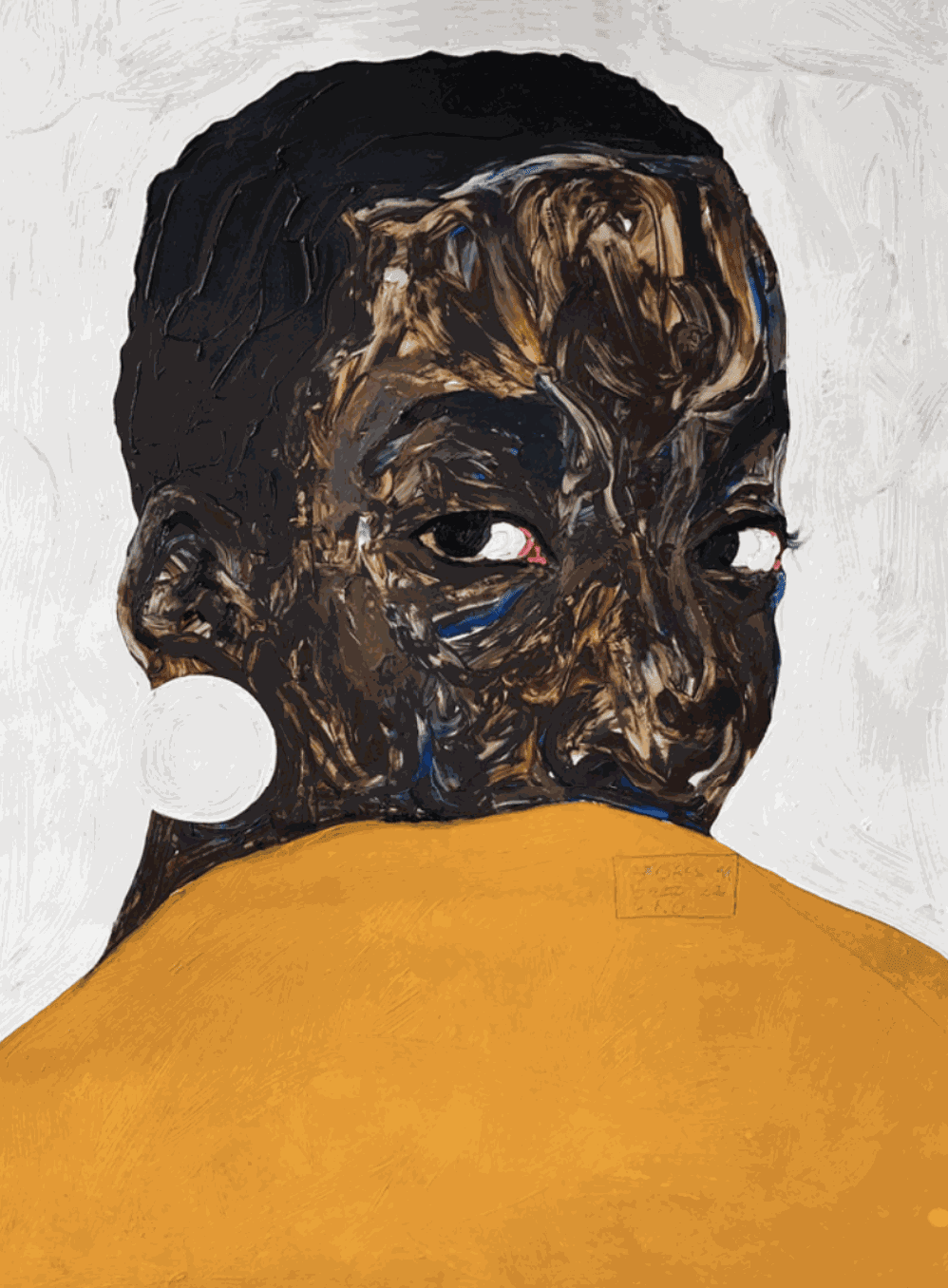 Amoako Boafo's Aurore Iradukunda, 2020
Amoako Boafo's Aurore Iradukunda, 2020Art Styles
An Introduction to Popular African ArtArt historians and artists of African descent have long highlighted the platitudes of the term ‘African art’. Typically, in the canon of art history, African art has been reduced to masks, votive figures, weapons or tapestries. However, curators, African art historians, and creators have been fighting against this one-dimensional view of African cultural output, in the aims of presenting a diverse and rich African arts scene, as variegated and unique as there are as many countries on the continent.
Here at Pavillon54, one of our main missions is also to educate and promote the incredible assortment of artistic styles and techniques that can be found in modern and contemporary African art. We’ve highlighted seven popular art styles that are worldwide and universal, already well-integrated in the art historical canon, but here we are presenting it with a unique African twist. How have modern and contemporary African artists contributed to these popular artistic movements, and who are the key players? Read on to discover more!
-
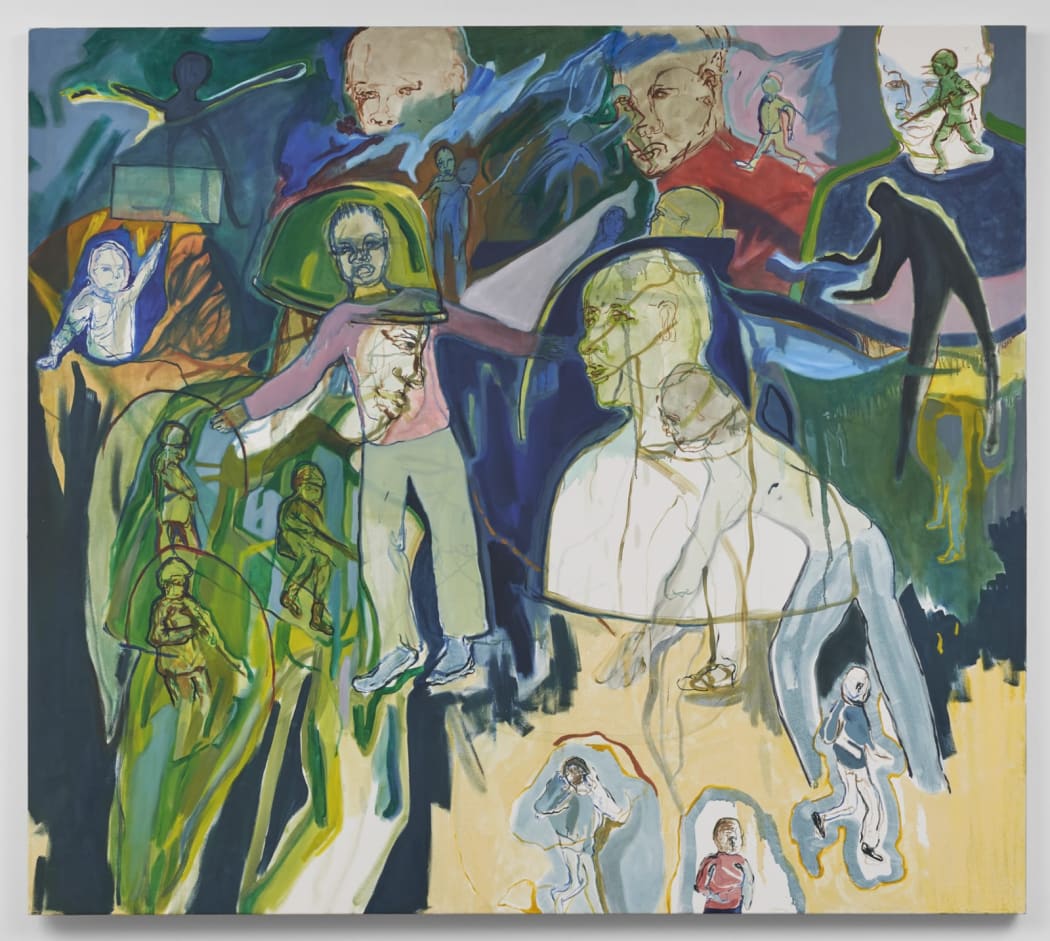 Chemutai Ng'ok's An Ultimatum, 2019 © Ben Westoboy
Chemutai Ng'ok's An Ultimatum, 2019 © Ben WestoboyArt & Power: art creativity and politics from Africa and the diaspora
A Brief Insight into Reflections of Power, Protest & LeadershipElections always raise hope for political change. October and November 2020 have made no exception, not mentioning the recent military coup and the progressive return to civilian rule in Mali. Guinea, Ivory Coast, Tanzania or the United States have all elected a new President or reappointed the outgoing one. Guinea hasn’t experienced much political stability since its independence. In Ivory Coast, Alassane Ouattara is about to secure an unprecedented third term as president since the adoption of the third constitution in 2000, "a sacrifice" in his words¹. The presidential mandate of John Magufuli's has been renewed for a second five-year term after Tanzanian elections marked by increased security and the arrestation of opposition leaders. These political transitions often imply a prologue and an aftermath in which the population lets its preferences and reaction heard, and in which (future) appointed leaders assume responsibility.
-
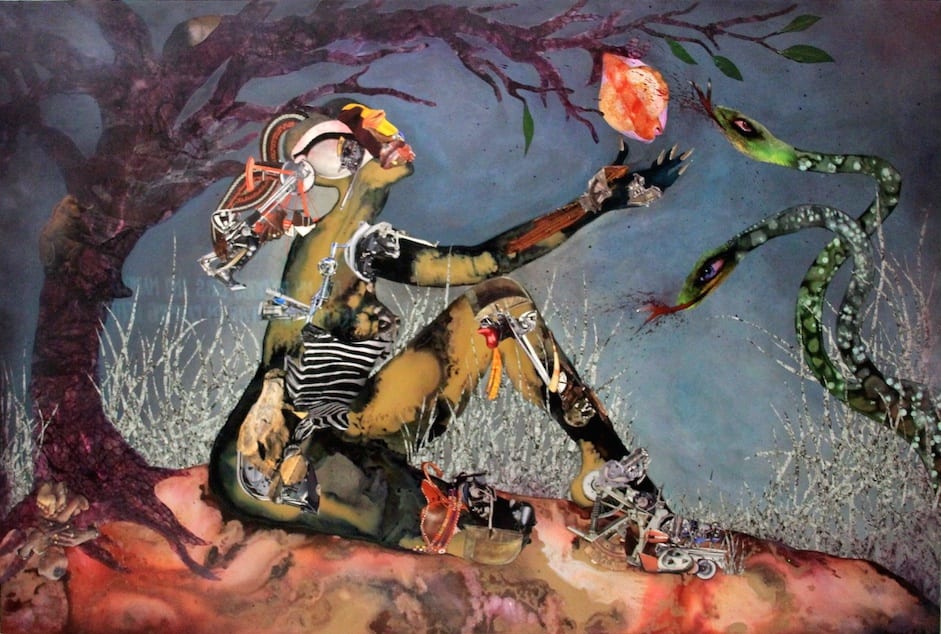 Wangechi Muti, Forbidden Fruit Picker (2015)
Wangechi Muti, Forbidden Fruit Picker (2015)Take a look at our list of the ten most expensive African artists to date, and you’ll see that women take up a significant proportion of the cut—even taking the top place! Unlike in the Western contemporary art market, top female African artists often see great success and prominence in their careers, on par with their male counterparts. In this article, we break down which seven female African contemporary artists are stealing the show, and the ones you should keep an eye on.
-
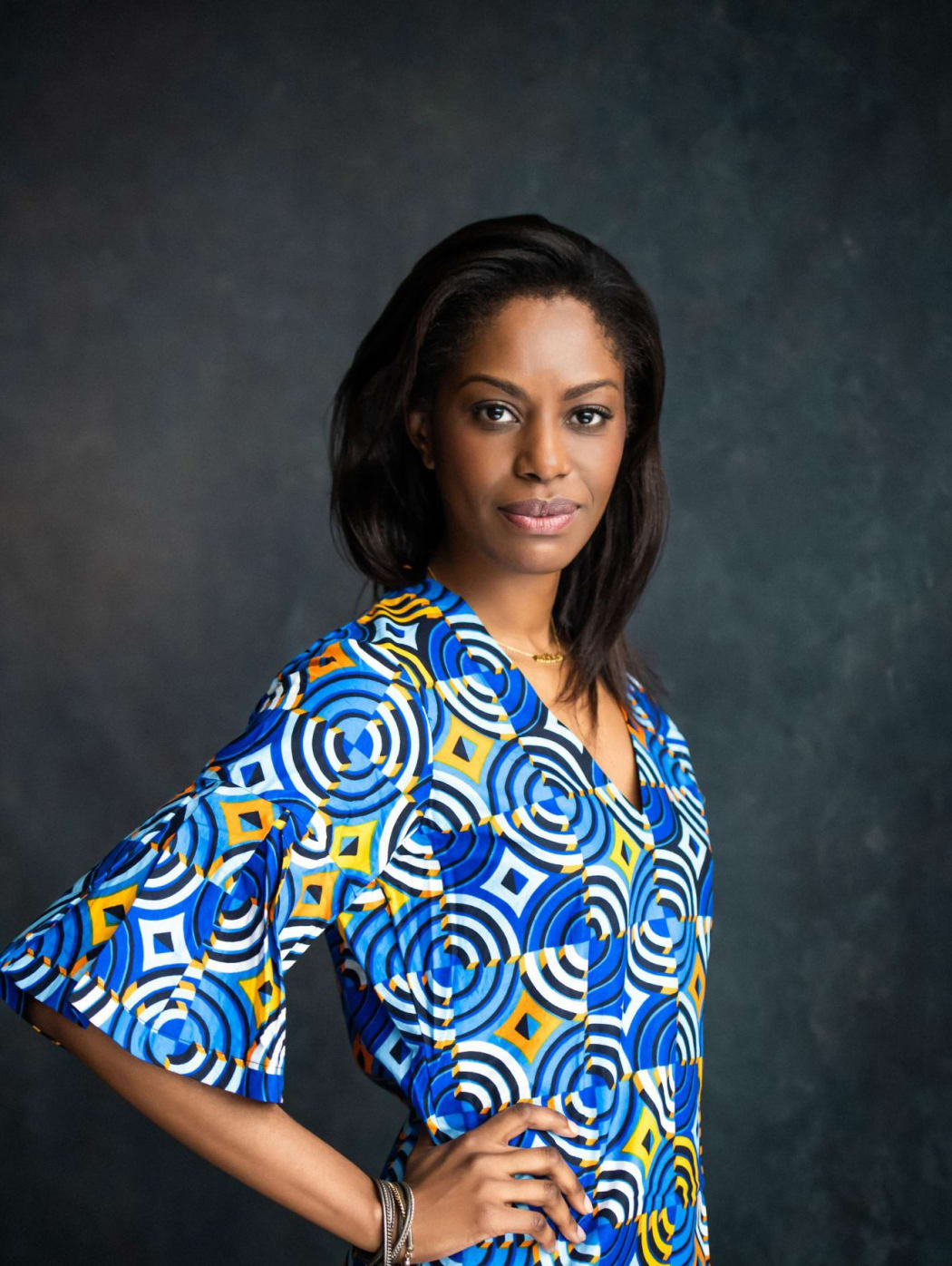 Dana Endundo Ferreira, CEO & Founder @ Pavillon54
Dana Endundo Ferreira, CEO & Founder @ Pavillon54Why Pavillon 54?
A word from Dana Endundo Ferreira, Founder of Pavillon 54, about building the global technology platform for African creativityA word from Dana Endundo Ferreira, Founder of Pavillon 54, about building the global technology platform for African creativity
-
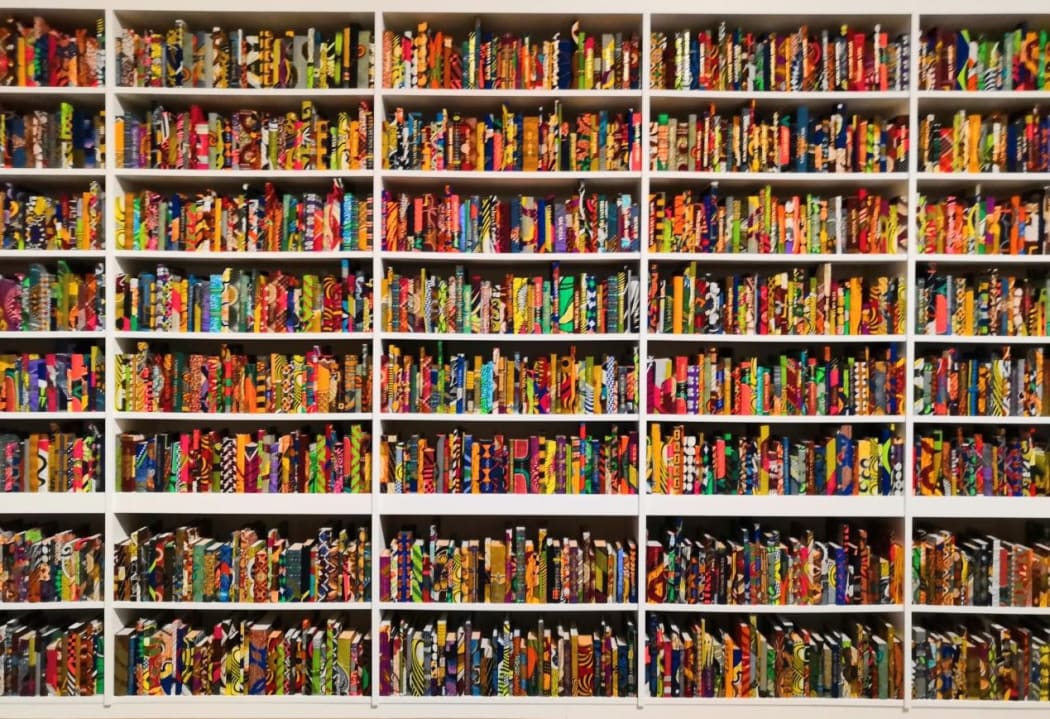 Yinka Shonibare CBE, The British Library 2014 (detail) | © Tate
Yinka Shonibare CBE, The British Library 2014 (detail) | © TateAs auction houses establish sales dedicated to African modern and contemporary art, galleries look to diversify their rosters of artists, and the African art market continues to grow, it is important to take note of which artworks and artists are performing well. This is especially true if you are hoping to make an investment in African art. Below, we have compiled the top 10 most expensive African artists to date, highlighting which works landed them the record-breaking position, and why.
-
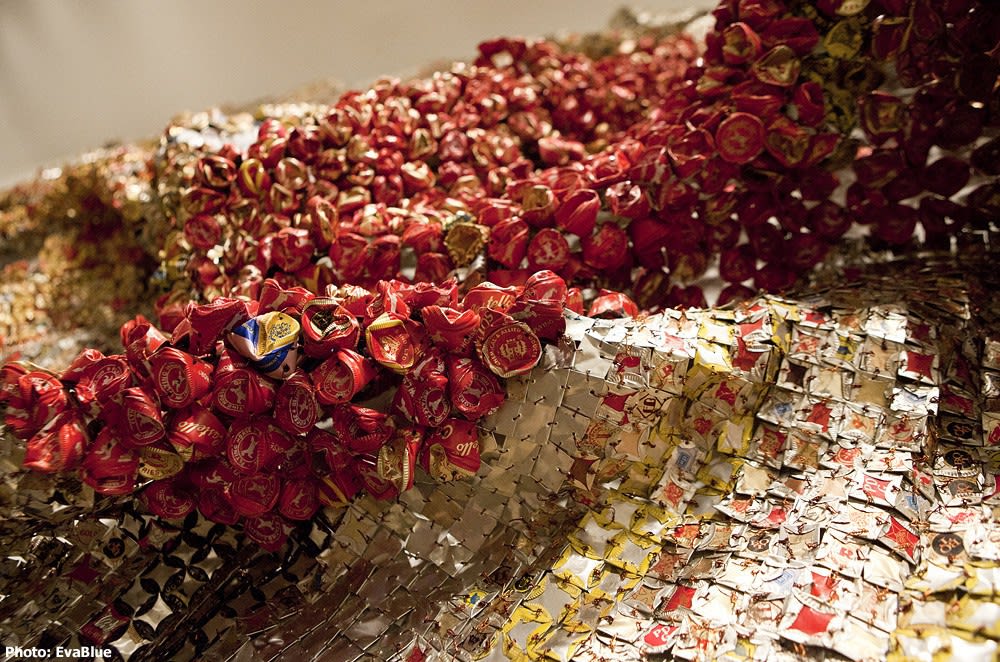 El Anatsui's Gravity and Grace Monumental Works (2009), Brooklyn Museum | © Eva Blue-Flickr.jpg
El Anatsui's Gravity and Grace Monumental Works (2009), Brooklyn Museum | © Eva Blue-Flickr.jpgEl Anatsui
Of Bonds and Bottle CapsAs you descend the steps into the British Museum’s ‘Africa’ wing, you are immediately confronted by a sculpture, large in scale, that resembles a swathe of draped cloth—except the piece is made from bottle tops and discarded wrappers. It is ‘Man’s Cloth’ by El Anatsui, a piece made in his distinctive wall sculpture style. So it is that this Ghanaian contemporary artist cemented himself within African Art History in the eyes of one of the Western world’s most prominent public institutions.
-
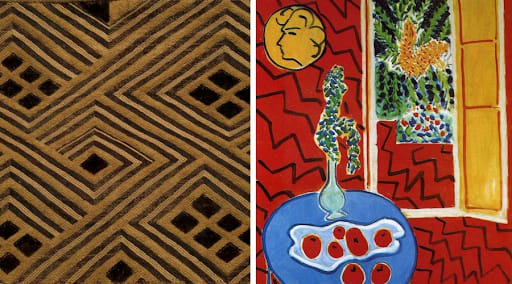 Left: Kuba Cloth from Matisse’s Collection, artist unknown. Right: Matisse's Red Interior still life on a blue table (1942)
Left: Kuba Cloth from Matisse’s Collection, artist unknown. Right: Matisse's Red Interior still life on a blue table (1942)Inspired by Africa: Henri Matisse
Series: Inspired by AfricaThe influences of African art on various artists and movements throughout history recount fascinating stories of cultural exchange, theft, homage and colonialism. In this series of articles, Inspired by Africa, we assess the ways that some of the most famous artists in the world borrowed from African art to create some of their masterpieces. For the third installation of this series, we survey the works of Henri Matisse, and the African countries he took inspiration from.
-
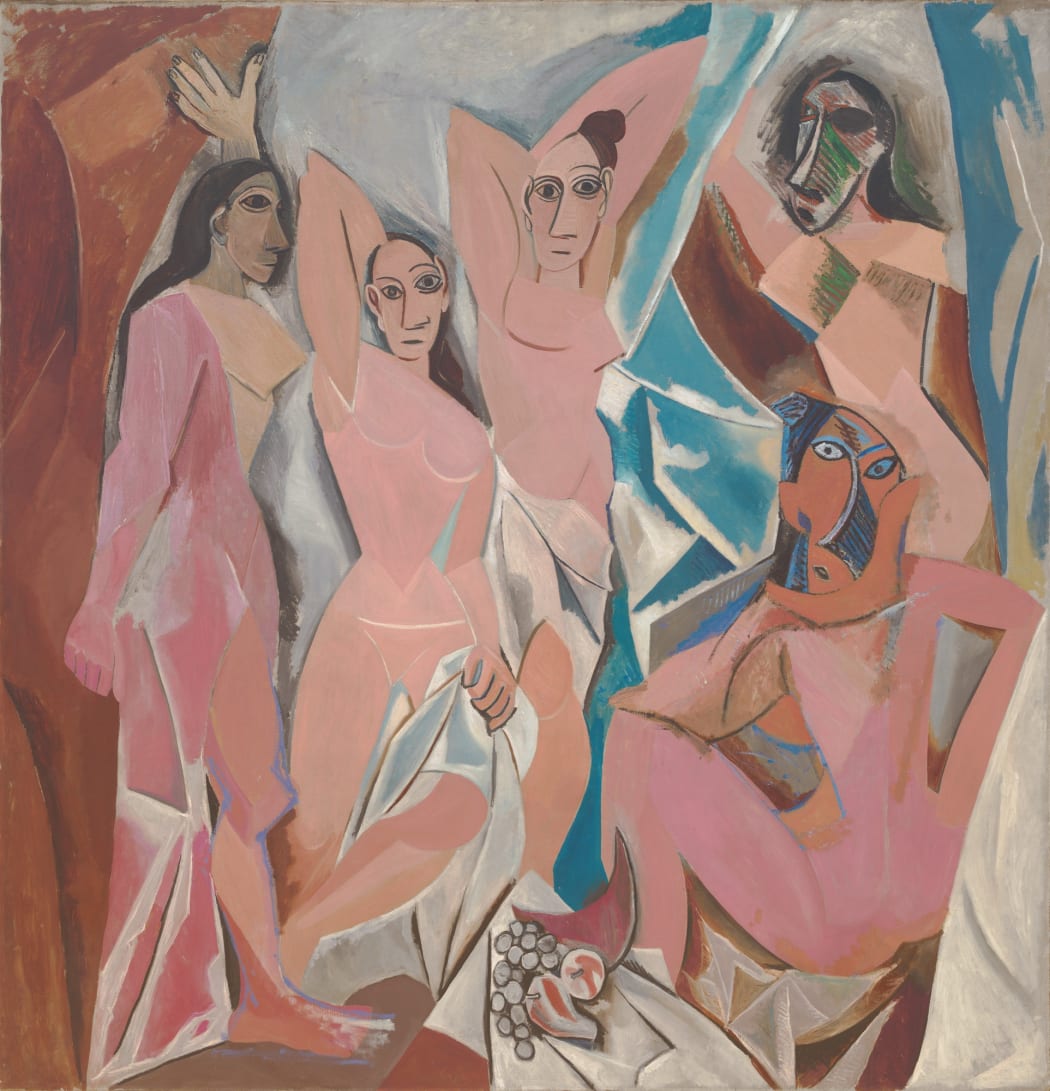 Pablo Picasso's Les Demoiselles d'Avignon (1907), oil on canvas, 243.9 cm × 233.7 cm
Pablo Picasso's Les Demoiselles d'Avignon (1907), oil on canvas, 243.9 cm × 233.7 cmInspired by Africa: Pablo Picasso
Series: Inspired by AfricaThe influences of African art on various artists and movements throughout history recount fascinating stories of cultural exchange, theft, homage and colonialism. In this series of articles, Inspired by Africa, we assess the ways that some of the most famous artists in the world borrowed from African art to create some of their masterpieces. First and foremost, we visit the works of perhaps the most acclaimed artist of the modern era: Pablo Picasso.
-
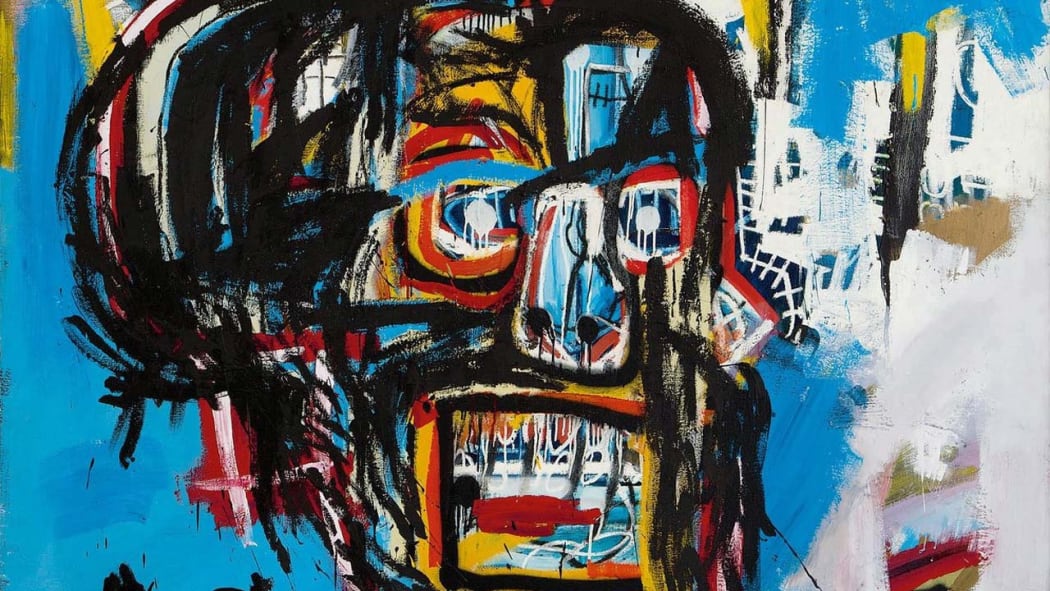 Jean-Michel Basquiat's Untitled (1982), work in oil stick, acrylic and spray paint
Jean-Michel Basquiat's Untitled (1982), work in oil stick, acrylic and spray paintInspired by Africa: Jean-Michel Basquiat
Series: Inspired by AfricaThe influences of African art on various artists and movements throughout history recount fascinating stories of cultural exchange, theft, homage and colonialism. In this series of articles, Inspired by Africa, we assess the ways that some of the most famous artists in the world borrowed from African art to create some of their masterpieces. For this second exploration, we examine how adored New York artist Jean Michel-Basquiat searched his roots to battle racism and create his unique artistic vision.
-
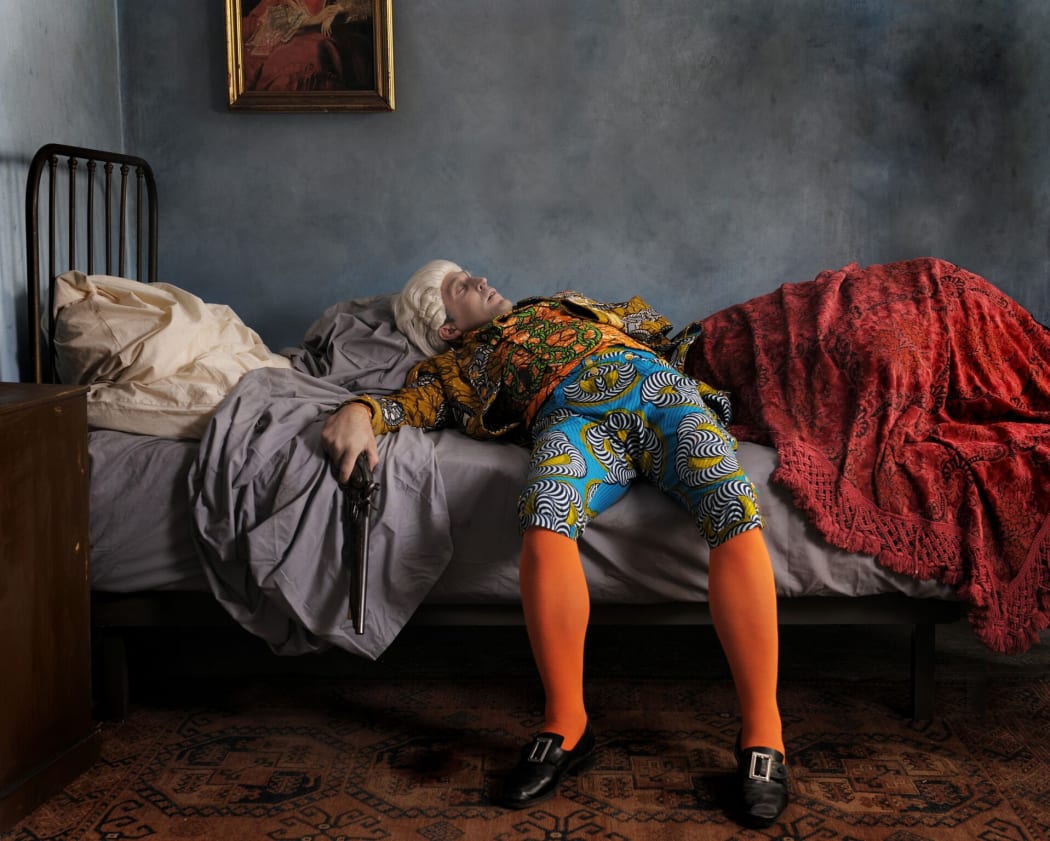 Yinka Shonibare's Fake Death Picture (The Suicide - Manet) (2011), digital chromogenic print
Yinka Shonibare's Fake Death Picture (The Suicide - Manet) (2011), digital chromogenic printYinka Shonibare, CBE (RA)
A Foot in Two ContinentsThe story of British-Nigerian artist Yinka Shonibare is one that spans two continents, countries and cultures. He was born in London, but moved to Nigeria when he was three years old, where he spent his childhood. The straddling of these two nations, and ultimately two cultural identities, thus has a profound influence on his work, which often engages with themes of identity, globalisation and post-colonisation.
-
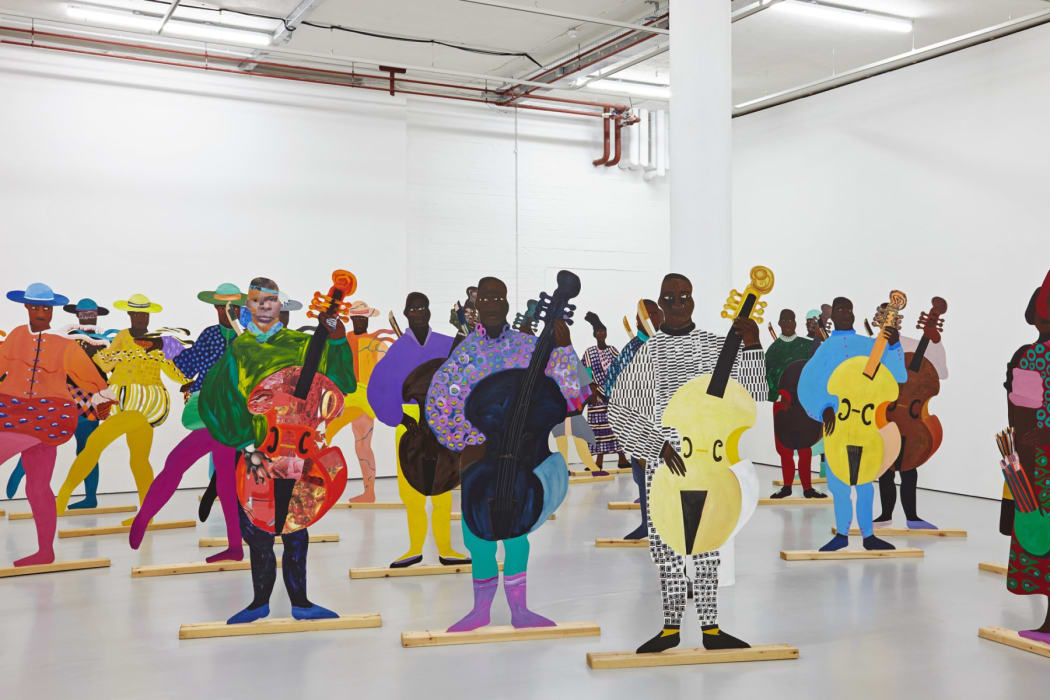 Lubaina Himid's Navigation Charts Spike Island (2017) | © Photo: Stuart Whipps
Lubaina Himid's Navigation Charts Spike Island (2017) | © Photo: Stuart WhippsLubaina Himid CBE (b.1954) is both an artist and a curator. She has made her mark in the art world by furthering the Black Arts Movement, of which she was one of the primary members in the United Kingdom in the 1980s. She particularly centres her work around black female artists, both in terms of subject matter for her own art, and assisting the careers of fellow women artists.
